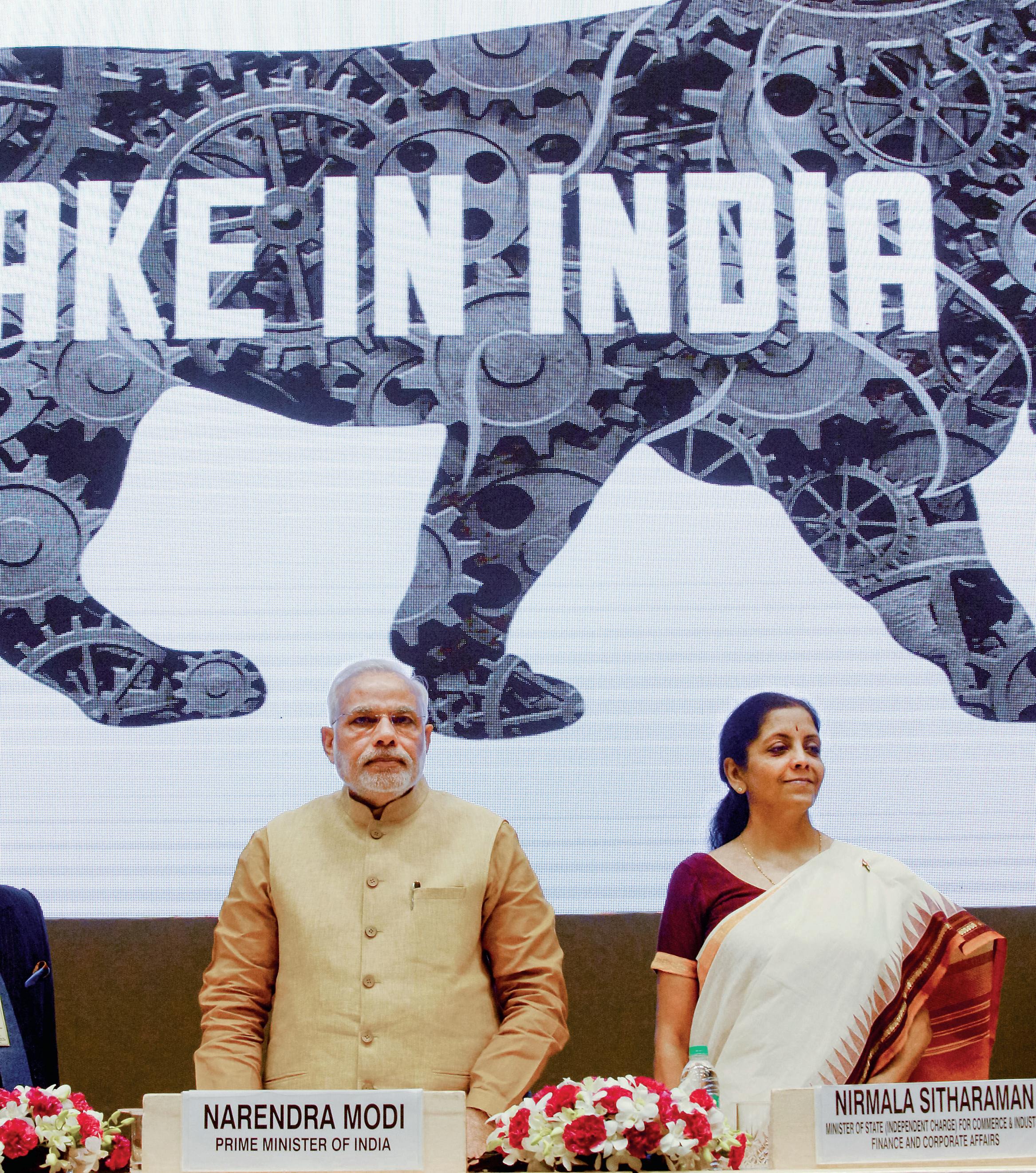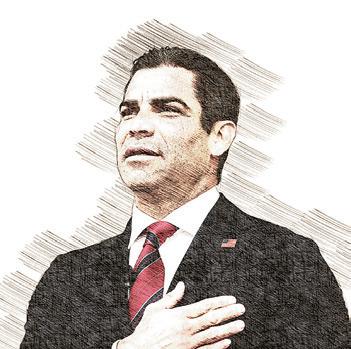A New Kind of Battle
Pentagon faces backlash as it joins ideological arena
 By John Haughey
By John Haughey

 By John Haughey
By John Haughey
the military’s venture into the ideological amphitheater began during the Trump administration—at the same time the president was signing executive orders to cast it out.
The secretary of defense at the time, Mark Esper, cracked the door to the progressive ideology of “diversity, equity, and inclusion” (DEI) in the military and it has been flooding the ranks ever since.

In recent years, the Pentagon has even doubled down on DEI-related and critical race theory training.
The military is now experiencing its most significant recruiting shortfalls in the half-century history of the all-volunteer force.
The Army missed its 2022 recruiting goal by 15,000 active-duty soldiers, or 25 percent of its target. The Navy also fell shy, even after lowering its recruiting quota, increasing its oldest enlistment age to 41 from 39, and relaxing other standards, including for those with criminal backgrounds.
“Asking young Americans to put their lives on the line for a nation they are required to acknowledge is inherently racist” is not a good recruitment strategy, said Thomas Spoehr, Heritage Foundation defense expert and a former Army lieutenant general.
“Is anyone surprised that potential recruits ... don’t want to spend their time being lectured about white privilege?” he told Epoch Times reporter John Haughey.
The Pentagon, meanwhile, is shrugging off the recruiting issues, attributing them to “a strong job market and quality-of-life issues.”
Find out more about the “woke” Pentagon and how experts believe it can be turned around, in this week’s cover story.
The Pentagon’s focus on diversity, equity, and inclusion training is hurting the U.S. military.
JASPER FAKKERT EDITOR-IN-CHIEFCHANNALY PHILIPP
LIFE & TRADITION, TRAVEL EDITOR
CHRISY TRUDEAU MIND & BODY EDITOR
CRYSTAL SHI HOME, FOOD EDITOR
SHARON KILARSKI ARTS & CULTURE EDITOR
BILL LINDSEY LUXURY EDITOR
FEI MENG, BIBA KAYEWICH ILLUSTRATORS
SHANSHAN HU PRODUCTION
CONTACT US THE EPOCH TIMES ASSOCIATION INC. 229 W.28TH ST., FL.7 NEW YORK, NY 10001

SUBSCRIPTIONS
READEPOCHINSIGHT.COM
GENERAL INQUIRIES, LETTERS TO THE EDITOR HELP.THEEPOCHTIMES.COM
ADVERTISING
ADVERTISENOW@EPOCHTIMES.COM
(USPS21-800) IS PUBLISHED WEEKLY BY THE EPOCH MEDIA GROUP, 9550 FLAIR DR. SUITE 411, EL MONTE, CA 91731-2922. PERIODICAL POSTAGE PAID AT EL MONTE, CA, AND ADDITIONAL MAILING OFFICES.
POSTMASTER: SEND ADDRESS CHANGES TO THE EPOCH TIMES, 229 W. 28TH STREET, FLOOR 5, NEW YORK, NY 10001.
Jasper Fakkert Editor-in-chief
22 | No Appetite for ESG
Shareholder support for ESG policies has halved in the past two years.
30 | The New China?
A look into India’s trajectory as a global manufacturing and economic powerhouse.
36 | Social Media
An investigation reveals Instagram’s algorithms connect pedophiles to victims.
40 | Trans Ideology
State AGs join a mother in her fight for parental rights in schools.
52 | Cancer Surge
Rise in HPV-related throat and mouth cancers signals public health concern.
56 | Government Overreach
The U.S. economy faces far more serious problems than high inflation.
57 |
The Biden administration’s weak China strategy is empowering Beijing.
58 |
Strong household finances will most likely moderate the coming recession.
59 |
The World Health Organization is calling for a “simulation” of the next pandemic.
The push to instill diversity, equity, and inclusion training in the military is backfiring.
26 |
A new report alleges Catholic hospitals are facilitating transgender surgeries.
Not every Republican candidate has his or her sights set on the presidency.
48 |
Learn how to limit your exposure to harmful electromagnetic fields.
The House of Representatives voted to censure Rep. Adam Schiff (D-Calif.) for allegedly perpetuating misinformation against former President Donald Trump, on June 21. Schiff has been referred to the House Ethics Committee for investigation.

60 | Market Rally
The stock market is pricing in too much monetary easing and optimism.
61 | China’s Reopening
The Chinese economy could now be in deep peril.
62 | Pentagon Reform
A former defense secretary says the Pentagon needs major reforms.
68 | Consider the Alternatives
Just because “it’s always done this way” doesn’t make it right.
70 | Palm Springs
Compound
There’s plenty of room for guests at this 28-acre estate.
72 | African Adventures
Exploring South Africa’s fascinating Zulu culture and heritage.
75 | Helping Hands
At Comfort Farms, veterans use food to heal the scars of battle.
76 | Summer Hiking Gear
A few “just in case” items to consider bringing on day hikes.
79 | Water Toys
This selection of gear will make summer boating even more fun.
83 | Sandy Etiquette
Proper manners for days spent at the beach.

THE BEDROOM OF QUEEN MARIE-ANTOINETTE de Habsbourg-Lorraine, wife of France’s King Louis XVI, at the Palace of Versailles in France, on June 19. She was the last queen of France before the French Revolution.

 PHOTO BY CHRISTOPHE ARCHAMBAULT/AFP VIA GETTY IMAGES
PHOTO BY CHRISTOPHE ARCHAMBAULT/AFP VIA GETTY IMAGES

Cellphones and other high-tech devices have become an integral part of people’s lives. However, studies show that the human heart is sensitive to EMF radiation from those devices and that it can lead to cardiac symptoms.

This year has seen a drop in investor support for ESG proposals, statistics show. 22
India is on a unique trajectory of growth that sets it apart from China, experts say. 30
48
Instagram’s algorithms effectively served as the pimps that connected pedophiles to children, a report suggests.
36
22%
Researchers have linked an increase of 22 percent in fatal road crashes in several U.S. states to the legalization of marijuana, according to a University of Illinois Chicago School of Public Health study.
26%

A PriceWaterhouseCoopers study has found that 26 percent of American workers plan to change employers in the next 12 months in hopes of finding better paid work, up from 19 percent last year.

50%
Rep. James Comer (R-Ky.) says that “over 50 percent” of the contents were redacted from documents he recently viewed regarding allegations about President Joe Biden’s family business dealings and potential bribes.
A federal judge has sentenced former CNN producer John Griffin to 19 years in prison for his involvement in illegal sexual acts with a minor.
$600 BILLION Uninsured deposits at U.S. banks fell by almost $600 billion in the first quarter of 2023, according to an S&P Global Market Intelligence report.
“Based on our investigation, it is not a legitimate basis to open a full investigation.”
“I’m worried that we’re just drifting into war.”John Durham, special counsel, referring to the basis of the FBI’s investigation of thencandidate Donald Trump’s campaign

texas has signed into law a bipartisan bill to combat the Chinese regime’s criminal practice of forced organ harvesting, making it the first U.S. state to counter the abuse through legal means.
Under SB 1040, which was signed by state Gov. Greg Abbott and takes effect on Sept. 1, it will be illegal for health insurance providers to fund organ transplants originating from China or any other country known to have involvement in the practice of forced organ harvesting. The bill passed unanimously through both of the state’s legislative chambers last month.
president joe biden’s son , Hunter Biden, has pleaded guilty to intentionally failing to pay federal income tax, U.S. Attorney David Weiss said in a letter to the U.S. court in Delaware.

Biden was also charged with violating a law that forbids a person who illegally uses a controlled substance from possessing a firearm.
He has agreed to enter a pretrial diversion agreement on the firearm charge, which is a felony, according to Weiss. Pretrial diversion programs enable defendants to get charges dismissed if they meet certain criteria.
anheuser-busch’s global chief marketing officer, Marcel Marcondes, says the boycott against Bud Light was a “wake-up call” and claimed the light beer will make a comeback.
Bud Light, in a social media promotional campaign, produced a personalized beer can with transgender activist Dylan Mulvaney in early April, drawing immediate consumer backlash. Some country singers and conservative influencers suggested that consumers not purchase the beer, causing sales to drop in every consecutive week following the Mulvaney backlash.
Marcondes told marketers at the Cannes Lions marketing conference in France that the backlash was a “wakeup call” for marketers like himself to be “very humble” amid controversy and during “times like this,” according to a report from AdAge.
a whistleblower from the company whose submersible went missing during an undersea expedition to the Titanic had raised safety concerns ahead of the craft’s maiden voyage and was later fired.
David Lochridge once served as the director of marine operations at OceanGate, the firm whose “Titan” submersible went missing on June 18 during a deep dive to the wreckage of the Titanic. On June 22, U.S. Coast Guard officials said a “catastrophic implosion” likely occurred.
Lochridge was fired in January 2018 after flagging concerns about the craft’s carbon fiber hull and other systems, according to a lawsuit Lochridge brought against OceanGate after his dismissal.
an indian airline has signed a deal for the largest aircraft order in the history of the airline industry with French aerospace firm Airbus.
The aircraft manufacturing firm announced that discount Indian airline IndiGo had placed an order for 500 of its family of A320 commercial jets, which are to be delivered between 2030 and 2035.
The deal sets “the record for the biggest single purchase agreement in the history of commercial aviation,” Airbus said in a statement.
the u.s. department of d efense says it has overcounted the value of the weapons it sent to Ukraine over the past two years by $6.2 billion. This error occurred because U.S. military officials didn’t count the actual value of what was pulled from the Pentagon’s weapons stockpile and sent to Ukraine but instead used the value of replacing those weapons, according to deputy Pentagon press secretary Sabrina Singh. Newly produced weapons typically cost more than the excess old ones they will replace.

president joe biden has called Chinese leader Xi Jinping a “dictator” while recalling the spy balloon incident, after Secretary of State Antony Blinken concluded his visit to Beijing in an attempt to stabilize U.S.–China ties.
Biden said the incident with the Chinese spy balloon, which was shot down by the U.S. military after being blown off course over the United States, had caused “great embarrassment” for Xi.
“The reason why Xi Jinping got very upset in terms of when I shot that balloon down with two box cars full of spy equipment in it was he didn’t know it was there,” Biden said at a fundraising event in California.

“That’s a great embarrassment for dictators when they didn’t knowa what happened.”
The latest purchase brings the total number of Airbus planes ordered by IndiGo to 1,330.
the interruption of education during COVID-19 lockdowns
“damaged a generation,” England’s former chief medical officer (CMO) Sally Davies says.
Giving evidence to the COVID-19 inquiry, Davies, who is now the master of Trinity College in Cambridge, said education “has a terrific amount of work to do” to mitigate the effects on children and students.
Davies was England’s CMO between March 2011 and September 2019, months before SARS-CoV-2, the virus that causes COVID-19, spread worldwide.
The British lockdown had a range of negative effects on children such as the rise of eating disorders and self-harm in teens, and developmental delays in babies and toddlers, studies have found.








1 . A racehorse is hosed down after a race at Mornington Racecourse in Melbourne, Australia, on June 21.

2. Visitors welcome the sun at Stonehenge in Wiltshire, England, on June 21. In the Northern Hemisphere, the longest day of the year falls on June 21, also known as the summer solstice.

3. A dog sits on its owner’s belly during a mass yoga session on International Yoga Day in New York’s Times Square on June 21.

4. Indian Air Force Sarang Helicopters team perform during a graduation ceremony at the Air Force Academy in Dundigal, India, on June 17.
5. The Cuauhtemoc, a training vessel of the Mexican Navy, sails the Seine river during the Grand Parade on the last day of the Armada de Rouen 2023, in Rouen, France, on June 18.


The three largest branches—the Army, the Navy, and the Air Force— fell short, or only marginally attained recruiting goals in 2022.
PHOTO ILLUSTRATION BY THE EPOCH TIMES, BURAKYALCIN/ SHUTTERSTOCK
Push to instill diversity, equity, and inclusion training in military is backfiring
MILITARY
The directive came from the top: A memo from the U.S. secretary of defense ordering Pentagon leaders and the commanders of the six military branches to review and recommend changes to “policies, programs, and processes that may negatively affect equal opportunity, diversity, and inclusion for all our people.”

A month later, the secretary issued a second memo, titled “Immediate Actions to Address Diversity, Inclusion, and Equal Opportunity in the Military Services,” outlining a “three-pronged approach” for implementing those recommendations.
The secretary called for reviews to ensure diversity in promotions, prohibition of pregnancy-based discrimination, bias awareness, “bystander intervention in response to improper remarks or other communications made by peers or superiors,” and a Workplace and Equal Opportunity survey to “include metrics concerning harassment and discrimination, extremist groups and activities.”
The secretary was Mark Esper. The president was Donald Trump. It was the pandemic summer of 2020 and there was violence on the streets in the wake of the death of George Floyd.
As Esper—who Trump would later fire via a November 2020 tweet—was installing expanded focus on diversity, equity, and inclusion (DEI) training in the armed forces during the summer of 2020, the Democrat-controlled House and split Senate were deliberating the Fiscal Year 2021 National Defense Authorization Act (FY21 NDAA), the annual defense budget.
Congress incorporated Esper’s initiatives into the spending plan, adding a requirement for the Department of Defense (DOD) to establish a “chief diversity officer” and “senior advisors for diversity and inclusion” within each branch to advise on “training in diversity dynamics and ... leading diverse groups effectively.” The NDAA also called for renaming military bases bearing the names of Confederate generals.
The Trump administration, meanwhile, was objecting to DEI-related training being imposed on all federal employees, not just uniformed military.
A September 2020 directive from the Office of Personnel Management (OPM) required agencies to identify any training on topics such as “critical race theory” or “white privilege.”
training on these concepts within the uniformed services. Ensuing OPM guidance required that it approve all such training programs “before being used.”
Nevertheless, Congress adopted the FY21 NDAA, encoding the enhanced DEI training into statute. Before leaving office as president, Trump vetoed the defense budget, citing a host of objections, including the removal of Confederate generals’ names from military bases.
Trump issued an executive order during that same month prohibiting federal funding for training on “divisive concepts,” with specific reference to prohibiting teaching, instructing, or
In their final act of 2020, the House and Senate overrode Trump’s veto in supermajority votes and adopted the defense budget. It went into effect on Jan. 1, 2021—three months after the fiscal year began and three weeks before President Joe Biden would enter the Oval Office.
On Jan. 20, 2021, the day he was inaugurated, Biden issued an executive
“The military is a pyramid. You need a lot of junior people.”
Thomas Spoehr, director, Heritage Foundation Center for National Defense
order revoking Trump’s September 2020 directive and lifting its restrictions on DEI-related training in the military.
In June 2021, Biden issued another executive order to “enable Federal employees [including DOD], managers, and leaders to have knowledge of systemic and institutional racism and bias against underserved communities, be supported in building skillsets to promote respectful and inclusive workplaces and eliminate workplace harassment, have knowledge of agency accessibility practices, and have increased understanding of implicit and unconscious bias.”
Conservatives argued that DEI training, as it was being implemented in the military, was a misguided attempt to impose political correctness with little relevance in the ranks and was, in fact, hurting morale and exacerbating tensions, potentially degrading force readiness.
With Democrats in control of the House and the Senate knotted at 50-50, those 2021–22 objections by conservatives got nowhere. DEI proponents, largely progressives, argued that the military has always been at the forefront of societal change and that the new programs were merely updates of 1971 programs that were last addressed in 1997.
Conservatives were further agitated when Biden’s newly appointed secretary of defense, former U.S. Army Gen. Lloyd Austin, ordered a 60day stand down “to address extremism in the ranks” in the wake of the Jan. 6, 2021, U.S. Capitol protest.
least 20,000 soldiers short of its ideal 485,000 active-duty force in 2023. It has lowered its goal to 452,000.
Even military academies are seeing shortfalls. Applications to attend the Air Force Academy dropped by 28 percent for the class of 2026, the Naval Academy by 20 percent, and West Point by 10 percent.
Air Force Academy: -28%
Naval Academy: -20%
Two factors have changed the tenor of the debate in 2023: Republicans regained a narrow majority in the House in the 2022 midterms and the military is experiencing its most significant recruiting shortfalls in the half-century history of the all-volunteer force.
West Point: -10%
In addition to a strong job market and perceived quality-of-life issues, the DOD cites two other factors aggravating recruitment efforts. Only 23 percent of 17-to-24-year-old Americans are eligible, or capable, of serving because of obesity, low test scores, criminal records, and behavioral health issues, the Pentagon states.
Only the Marine Corps and newly created Space Force met recruiting goals in 2022 while the three largest branches fell short, or marginally attained reconfigured goals.
The Pentagon projects that trend will continue in 2023 in what it calls the “most challenging recruiting environment in the 50 years of the all-volunteer force,” primarily because of a strong job market and quality-of-life issues.
The Army missed its 2022 recruiting goal by 15,000 active-duty soldiers, or 25 percent of its target, leaving the nation’s largest military force 7 percent smaller than it was two years ago.
The Navy fell shy even after lowering its recruiting quota, increasing its oldest enlistment age to 41 from 39, and relaxing other standards, including for those with criminal backgrounds.
The Air Force met 2022 goals but anticipates missing its manpower objectives for the first time since 1999 by as much as 10 percent in 2023.
The Army estimates it will fall at
Plus, it notes, surveys show that only 9 percent of the nation’s military-age population has “a propensity to serve” in public service, including the armed forces, underscoring a growing “civilian and military cultural divide” where more than 80 percent of those now serving in the military come from families of military veterans.

During congressional hearings through winter and spring, senior military leaders said the recruitment shortfalls follow a historic pattern when competition from the private sector for workers increases.
In a May 11 hearing before the Senate Appropriations Subcommittee on Defense, Austin said “headwinds” fostered by “two years of COVID” are also impairing recruitment.
“It is not the first time we have seen challenges in recruiting,” he said, noting he was a recruiter himself at one point in his Army career. “I am optimistic” that the military will get out of “this trough” and attract the people needed to fill its lower ranks again soon.
Congressional Republicans, while acknowledging those claims, say the DOD is purposely overlooking another reason some young Americans, especially constituencies that traditionally have filled the all-volunteer ranks, aren’t
signing up: the Biden administration’s imposition of mandatory expanded DEI training and other “woke” programs, such as support for transgender members.
“Asking young Americans to put their lives on the line for a nation they are required to acknowledge is inherently racist” isn’t a good recruitment strategy, Heritage Foundation Center for National Defense Director Thomas Spoehr told The Epoch Times.
Right now, the former Army lieutenant general says “military leaders will have to fight a perception of political indoctrination” to meet recruitment quotas.
Spoehr said “direct ‘cause-and-effect’ studies on the impact of woke policies such as these do not exist,” but suggested that “common sense” dictates that they’re hurting recruiting.
“Is anyone surprised that potential recruits—of whom many come from rural or poor areas of the country—don’t want to spend their time being lectured about white privilege?” he asked.
Pentagon leaders and branch brass have refuted GOP claims regarding DEI’s alleged influence on recruiting and readiness by stating that there’s no anecdotal or statistical evidence to support the contention.
During more than four months of hearings, various DOD officials also blunted House Republicans’ claims by touting highest-ever military retention rates; if DEI was such an onerous issue, they insisted, those who’ve been subjected to the training wouldn’t be reenlisting at three times the rate of decades ago.
Spoehr said the key statistic not detailed is how many completing a first enlistment are signing on for another. Otherwise, it’s no surprise that those who’ve chosen to make a career in the military are making a career in the military.
“People in the military are not free agents,” he said, noting that they often have car loans, mortgages, and children in school like everyone else. “To some degree, they are invested already in service, in their pension plans. They’re not at complete liberty to leave. They will leave when they can. I do not take a lot of stock in retention [arguments].”
When retention outpaces recruitment, Spoehr warned, it’s indicative of things “getting out of whack” with a force that “gets older, gets more costly.”
“The military is a pyramid. You need a lot of junior people,” he said.
Rep. Mike Waltz (R-Fla.) also dismissed the Pentagon’s defense of DEI training by citing retention. While the DOD states that there are no data to support claims that DEI training is hurting recruiting, it’s avoiding asking questions about the programs in surveys canvassing prospective recruits about motivations to join or not join.
For instance, Waltz told The Epoch Times, he and others have asked the Navy if “they regularly collect data on why people are not enlisting? And, why they are not reenlisting? And, they don’t have it. Navy leadership may have their own opinions, their narratives” that no data could change.
shouldn’t say ‘mom’ or ‘dad’ or ‘girlfriend’ or ‘boyfriend.’ I would not have known that West Point was asking cadets to discuss their ‘white rage.’ This is coming from the service members.”
And he knows that contacting a congressional representative about perceived injustices is frowned upon.
“I would have been petrified as a cadet to go to a congressman” with complaints, Waltz said. “They feel they have no avenues to express discomfort.”
Spoehr “was not aware” of DEI training as a recruiting and readiness issue until he saw a 2021 Gallup poll “detecting this big drop in loss of confidence in the U.S. military” that cited “the disastrous withdrawal from Afghanistan, DEI programs, and support for transgenders to enter without restrictions.”
That, he said, was followed by an October 2022 analysis that maintained that “wokeism” was the “chief worry
A second reason, Waltz said, is “a so-so economy ... have you seen the bonuses they are offering?”
The first Green Beret ever elected to the House, Waltz is a West Point graduate and 26-year Army combat veteran who continues to serve as a colonel in the Florida National Guard.
He emphatically refutes the Pentagon’s contention that there isn’t ample anecdotal evidence that DEI is depressing recruitment.
“One of the things that I hope you can impart,” he told The Epoch Times, “is this is not an issue that a bunch of Republican lawmakers are making up or exacerbating for political reasons. This is coming from the ranks.
“I would never have known the Air Force suggests to cadets that they
of grizzled American veterans today.”
Spoehr wrote in an American Heritage column that month that veterans were alarmed by “the weakening of [the military’s] fabric by radical progressive (or ‘woke’) policies being imposed, not by a rising generation of slackers, but by the very leaders charged with ensuring their readiness.”
During a House Oversight Committee March 28 subcommittee hearing, Rep. Clay Higgins (R-La.) said people in southern states, always a mainstay in military recruiting, aren’t happy with the “‘wokeism’ permeating the Pentagon.”
“Southern families, conservative families, we are not going to encourage our young men and women to join the military and endure this stuff,” he said. “In society, ‘woke’ is a social discussion but in the military, ‘woke’ is weak—and that is the problem.”
The Pentagon refuses to see this dis-
Conservatives had argued for years that DEI training was hurting morale and exacerbating tensions, potentially degrading force readiness.
connect, Higgins said. He waved printouts of two Epoch Times articles that documented how, according to the Navy and Marine Corps, three of its biggest challenges are “climate instability, COVID’s ongoing impact, and strengthening a naval culture of inclusiveness and respect.”
“What’s happening now is families are holding our youngsters back. Families are saying, ‘Don’t join!’” he said.
The nation’s military leadership is a “laughingstock,” Rep. Paul Gosar (R-Texas) said during the hearing.
“The administration’s intent is clear—cleanse the military of conservatives, and the consequences are devastating,” Gosar said.
Rep. Andy Biggs (R-Ariz.) stated in a tweet: “The U.S. Army has fallen 15,000 soldiers short of its recruitment goal this year. Maybe we ought to stop imposing vaccine mandates, preferred pronouns, and ‘woke’ education training on them. Just a thought.”
A 2021 Military Family Advisory Network (MFAN) survey of more than 8,600 military families revealed that those
now serving were less likely to recommend their children enlist. Quality of life was the top-cited concern. MFAN’s survey doesn’t ask questions about politics.
But in testimony before Congress, Independent Women’s Forum senior fellow Dr. Meaghan Mobbs said the MFAN survey confirms what her group is hearing from veterans who are encouraging family members not to follow in their footsteps.
“Such a precipitous drop in such a short period of time is alarming,” she said, attributing that decline to DEI training and “wokeism.”
“Unfortunately, it will be many years before the full effect of such a decrease will be known, and it will take at least a generation to fix.”
Critics maintain that the Biden-era Pentagon is also relying on the fact that, as most veterans will recount, there’s always some form of “baloney”—not their most commonly used “b” word—that soldiers, sailors, airmen, guardians, and

Marines must endure during their time in the military.
Sure, Waltz said, it’s “just more nonsense, nothing new. That is what the services do. ‘Really, this is not that many hours, it’s a big picture thing.’”
But DEI training isn’t about fostering awareness and respect for each other, he said, it’s an indoctrination of the best of America’s youth.
“When you are imposing this stuff on very young 18- and 19-year-olds, it has an impact over time,” he said.
Waltz has filed the bill “Working to Address Recruiting and Retention to Improve Our Readiness (Warrior) Act,” which he says will “provide much-needed reforms to prevent the Biden administration from further politicizing the Department of Defense and improve military readiness.”
The bill would require the DOD to institute “a hiring freeze of Equal Opportunity [EO] and Equal Employment Opportunity [EEO] personnel at a ratio of 1:2,000 EO/EEO staff to uniformed service members.”
It would require the DOD to audit DEI programs “that have caused greater division within the force. These programs are diverting focus and resources away from lethality and readiness against our potential adversaries.”
The audit will require the secretary of defense to submit a report to the House and Senate Armed Services Committees, listing all FY22 DEI programs and expenses by Dec. 1.
“The report shall include a description of the purpose of the program and how many man-hours were spent participating in the program, billets and personnel (both civilian and uniformed) dedicated to each program, and the total costs associated with each program,” the bill states.
In the interim, the bill would bar “the use of appropriations to fund DOD race-conscious selections, assignments, accessions, or promotions,” prohibit “the instruction or propagation of critical theories, such as critical race theory as part of military training or at the service academies,” ban “the use of non-merit-based criteria in the consideration for selection for the military service academies,” and suspend “the use of appropriated funds to investigate extremism in the military.”
The bill would require “a cost/benefit analysis be submitted to Congress before funds are appropriated ... that af-
firms the proposed policies or programs will improve war-fighting capabilities and there is no less expensive alternative available.”
2022 letter from Joint Chiefs of Staff Chair Army Gen. Mark Milley estimated that the armed forces dedicated nearly 6 million hours and about $1 million in additional expenses to DEI training sessions in 2021.
“This averages to just over 2 hours per Service member in a total force of 2.46 million members and is comparable to other Joint Force periodic training requirements,” Milley wrote in the letter.
The GOP senators said they were “alarmed” by the data and accused Biden of being “more focused” on enacting a woke agenda in the military than on confronting America’s adversaries.
Their math took the Pentagon estimate and factored in the less-than-100 documented cases of “extremism” reported during the span, calculating that 58,000 hours of DOD manpower hours were expended in training for every instance.
Waltz’s proposed “Warrior Act” seeks a more complete audit of DEI programs than does those that the Pentagon has provided in response to Republican requests since 2021.
In response to Sen. James Inhofe (R-Okla.) and 11 other GOP senators, a
During the March 28 hearing before the House Oversight and Accountability Subcommittee on National Security, the Border, and Foreign Affairs, Veterans on Duty, Inc. Chair Jeremy Hunt testified that the Pentagon’s DEI program “subjects some service members to 11-week resident DEI training classes—despite the military’s history of leading the fight against discrimination.”
Hunt, a West Point graduate and former Army officer who is black, said his alma mater now “lectures cadets about ‘addressing whiteness,’ while the Air Force Academy has started the bizarre practice of appointing cadet DEI officials.”

He said the Army spent $114 million on DEI training in 2022 and “in some cases, we are paying these ‘DEI bureaucrats’ $200,000 a year” despite there being “no data to determine if it actually works, which we know it doesn’t, and whether there was any type of underlying data that necessitates the dramatic increases of this program.”
Spoehr said he believes Waltz’s bill will gain traction and be adopted because Democrats, even the progressives who lobby for DEI, are beginning to realize it could be affecting recruitment.
“Just the other day, Lloyd Austin decreed there would be no more drag queen shows on military installations. That came as a surprise to me. I thought they were heading down the path that we’re going to have drag queen story hour at

“I would never have known the Air Force suggests to cadets that they shouldn’t say ‘mom’ or ‘dad’ or ‘girlfriend’ or ‘boyfriend.’”
Rep. Mike WaltzCLOCKWISE FROM TOP L: SAMUEL CORUM/GETTY IMAGES, U.S. MARINE CORPS PHOTO BY SGT. MANUEL A. SERRANO, U.S. ARMY MEDICAL CENTER OF EXCELLENCE PHOTO BY TISH WILLIAMSON
the installation library,” Spoehr said.
He noted that there’s bipartisan concern about “military recruiting and readiness in the context of countering China.”
“People are taking this seriously. [Waltz’s] bill, I can see it succeeding,” he said.
Retired Navy Capt. Frederick J. Passman, continental commander of the Naval Order of the United States (NOUS), said mere presence in the military teaches people to “make sure that we respect various opinions.”
Stressing that he wasn’t speaking on behalf of the NOUS, which he emphasized is “apolitical and nonpartisan,” Passman told The Epoch Times, under current DEI protocols, “I feel very grateful for having been in when I was and to have served in the time that I did.”
He regards DEI training as “rocks and shoals” that place “too much focus on things that don’t have anything to do with the accomplishment of the mis-
sion. It is taking time away from mission accomplishment.”
A warship drilling to fight—and to survive a fight—will foster “good teamwork,” and doing so is “part and parcel ... of a successful command,” he said.
“The break-way times for specific types of training evolutions that aren’t related to mission accomplishment creates confusion and distractions and is counter-productive,” Passman said, noting what especially “bothers” him is “gender identification.”
“Superiors being called on the carpet because they didn’t use the proper pronoun for a subordinate? That is unacceptable.”
And besides, he said, in terms of the Navy, it already has a cadre of skilled “attitude-adjustment” specialists—the chiefs, the veteran-enlisted, noncommissioned officers who are the lifeblood of every ship, every squadron, every fleet.
“The best solution is what has always worked. Let the chiefs administer ‘attitude adjustment training,’” Passman
said. “Back in the day, you got ‘sea lawyers’ who end up mysteriously ‘tripping down the ladder to the boatswain’s locker.’ After a few years, they become excellent sailors. That is considered totally unacceptable these days.”
Paul Gagne of the Massachusetts NOUS, a retired chief who administered plenty of on-the-job “attitude-adjustment” training during his Navy career, said the whole DEI conversation is a bunch of “baloney.”

“I’m an old chief raised by old chiefs. I’m not going to sugarcoat this: The reality is the people you need to recruit are going to turn away,” he told The Epoch Times.
He also pointed a broadside to GOP politicians who may also need some “attitude adjustment.”
“I’m really tired of the ‘politi-speak,’ the ‘wokeism’ talk, the labels, the whole conversation,” Gagne said. “It’s not hard. It’s very simple. If you want a certain type of people in your service, market your recruiting to them.”
 BY KEVIN STOCKLIN
BY KEVIN STOCKLIN
This year’s spring season of shareholder voting is leading some to believe that the tide may be turning against the leftwing corporate pressure campaign that goes by the moniker of environmental, social, and corporate governance, or ESG.
“The big story this year is the drop in support for ESG proposals,” Scott Shepard, a fellow at the National Center for Public Policy Research (NCPPR), told The Epoch Times.
Citing data from the Sustainable Investments Institute, the Financial Times recently reported that proposals to compel corporations to act against climate change won approval from an average of 23 percent of shareholders, versus 36.6 percent in 2022 and about 50 percent in 2021. Support for proposals on social justice causes is also down by about 10 percentage points from last year.
Although the number of political and social shareholder proposals has increased, partly because of a 2021 Securities and Exchange Commission (SEC) rule change that allows more ESG petitions to go to a shareholder vote, only five of these proposals received majority approval from shareholders, compared to 34 in 2022.
The 2021 SEC ruling reversed a policy implemented under the Trump administration that allowed companies to exclude certain ESG petitions. This reversal by the Biden administration made 2022 “a blow-out year” for climate and racial resolutions, according to Heidi Welsh, executive director of the Sustainable Investments Institute.
Analysts ascribe this year’s drop in support for progressive petitions to a combination of anti-ESG efforts by red states, consumer boycotts, headline stock declines at companies such as Anheuser-Busch InBev and Target, fear of anti-trust investigations, and more light being shed on how the ESG industry works. These factors have raised questions about whether voting for these causes serves the pecuniary interests of their investors and whether asset managers are violating their fiduciary duties.
“The big three investment houses [BlackRock, Vanguard, and State Street]

and the proxy-advisory duopoly [ISS and Glass Lewis] are aware that they’re now under significant scrutiny, and that they may face legal, legislative, and regulatory challenges to their partisan behavior,” Shepard said. “So fewer certainly are chalking up wins. If that trend continues, as I expect it will, the focus must shift in part to what the investment houses are doing with the influence derived from other people’s money behind the scenes.”
Critics of the ESG industry say that politically motivated fund managers are leveraging the savings of people who trust them with their money to vote in favor of corporate shareholder proposals ranging from disinvesting in oil, gas, and coal to race and gender-based programs. Given that institutional asset managers control about 80 percent of publicly traded corporate shares, these firms have tremendous influence over the management of most publicly traded corporations today.
The response from customers and shareholders to social justice campaigns undertaken by Bud Light brewer Anheuser-Busch InBev, Target, Disney, Coca-Cola, and other activist corporations could be prompting corporate executives to reconsider steering their companies into controversial political issues.
The values of Target and Anheuser-Busch InBev have fallen by about $13 billion and $27 billion, respectively, after attaching their brands to controversial social justice causes. Stung by these losses, many investors worry that asset managers may be proxy-voting their shares against the interests of shareholders. For asset managers and corporate executives alike, this could create a legal liability.
On March 5, regarding the steep fall in Target’s share price, Elon Musk, founder of SpaceX and Tesla, wrote on Twitter, which he also owns, that it “won’t be long before there are class-action lawsuits by shareholders against the company and board of directors for destruction of shareholder value.”
On June 6, the NCPPR, a shareholder in Target, served the company’s management with a formal demand for corporate records regarding its promotion of LGBT products.
“Target has formally acknowledged to its shareholders the significant financial risks that would come from eroding positive public perceptions of its brand,” said Stephen Miller, president of America First Legal, which is representing NCPPR in the suit. “Yet Target went ahead and embraced the most radical and offensive excesses of anti-family, anti-child gender extremism, promoting products like ‘tuck-friendly’ bathing suits and Satanist-inspired clothing.”
Miller said Target is aligning its brand with an agenda that advocates puberty blockers and elective surgeries on healthy children.
“For Target to voluntarily and aggressively associate itself with this movement is an act of sabotage against Target shareholders and a destroyer of value, especially for countless Americans for whom shares of Target are part of the pension funds, mutual funds, and retirement accounts on which they depend,” he said.
On June 5, the Human Rights Campaign (HRC), which advocates for LGBT rights, stated that “recent pushback against businesses such as Anheuser-Busch and Target, blatantly organized by extremist groups, serves as a wake up call for all businesses that support the LGBT community.”
“Research shows that if a brand publicly supports and demonstrates a commitment to expanding and protecting LGBTQ+ rights, Americans are 2 times more likely to buy or use the brand,” the HRC stated. “It isn’t just LGBTQ+ consumers and communities: 70 percent of non-LGBTQ+ people believe companies should publicly support and include the LGBTQ+ community through practices like hiring, advertising, and sponsorships. At this moment, it’s critical that Target champions equity and inclusion as it has for over a decade.”
Anheuser-Busch, which previously had a perfect 100 percent score on the HRC’s Corporate Equality Index, had its rating suspended by the organization on May 9, one month after the brewer appeared to backpedal on its transgender promotional campaign for Bud Light following a drop in beer sales.

The Walt Disney Company saw similar pushback from shareholders. On April 5, Reed Rubinstein, former deputy attorney general in the Trump administration, issued a letter on behalf of share-
holders to Disney’s board of directors, demanding a corporate investigation into CEO Bob Chapek’s “wasting of corporate assets,” including damage to Disney’s brand and reputation, as well as Disney’s violation of employees’ civil rights by fostering a discriminatory and hostile work environment against conservative staff.
PETITIONS ASKING U.S. COMPANIES for more action on climate change won approval from an average of 23 percent of shareholders as of the end of May, down from 36.6 percent from same time last year.
ONLY 5 POLITICAL AND SOCIAL shareholder proposals received majority approval from shareholders, compared to 34 in 2022.
23% 80%
INSTITUTIONAL ASSET MANAGERS control about 80 percent of publicly traded corporate shares and thus have tremendous influence over the management of most publicly traded corporations.
This came after Disney fought against a parents’ rights law in Florida that banned the teaching of sexual topics to children in kindergarten through third grade. Chapek was fired by Disney in November 2022, with a $24 million severance package.
In addition to shareholder actions, more than a dozen states, including Florida, Texas, West Virginia, Utah, Kentucky, and Oklahoma, have passed or are considering passing laws and regulations to prevent state funds from being used to support the ESG industry. Some states have also boycotted banks and asset managers that they say discriminate against industries according to the ESG agenda.
“Conservative state treasurers and AGs have been pulling out all the stops to stop ESG,” Yitz Friedman, communications manager at the American Accountability Foundation (AAF), told The Epoch Times. “However, most state capitals have a ‘swamp’ of their own to deal with, and we have seen reluctance on the part of state pension boards to seriously address the ESG threat.”
The AAF reported that, despite laws and regulations in Florida and Ohio that require state fund managers to make investment decisions and vote shares only according to monetary criteria, fund managers have continued to support progressive petitions in shareholder votes. Fund managers in Florida and Ohio reportedly voted for corporate resolutions in favor of climate and racial causes at companies including Boeing, UPS, AT&T, Home Depot, Disney, and ExxonMobil.
However, the Ohio Public Employees Retirement System (OPERS), which manages the state’s investments, denied that political issues were a factor.
“OPERS does not permit ideologies to influence our investment or proxy voting decisions,” Michael Pramik, an OPERS spokesman, told The Epoch Times.
As conservative states fight ESG, liberal states have been ramping up demands that asset managers include ESG in their investment decisions. In September 2022, fearing that BlackRock, the world’s largest asset manager, was faltering in its support for ESG initiatives, New York City Comptroller Brad Lander wrote BlackRock CEO Larry Fink demanding that “stronger action toward net zero emissions reduction across its portfolio.”
“Your 2021 letter to CEOs committed to ‘supporting the goal of net zero greenhouse gas emissions by 2050 or sooner’—in line with BlackRock’s pledge as a signatory to the Net Zero Asset Managers Initiative (NZAMI)—and asked businesses to disclose how they are integrating their own net zero plans into their longterm business strategies,” Lander told Fink. “Unfortunately, despite these repeated proclamations ... BlackRock now abdicates responsibility for driving net zero alignment in its own portfolio by saying that it does not ask companies to set specific emissions targets” as a result of pressure from conservative state AGs and financial officers.
Fink had famously declared in 2017, as the ESG movement was picking up steam, that “you have to force behaviors, and at BlackRock, we are forcing behaviors.”
Lander, who directs New York’s nearly $200 billion in pension assets, suggested that the city might take its business elsewhere if BlackRock failed to “use its position as the world’s largest asset manager, with all the corporate governance responsibilities that go along
with that position, to move its portfolio companies to get their businesses in line with a net zero economy.”
This pressure from ESG advocates highlights the difficulties that companies face once they take on ESG causes. Having taken a political position, they soon face backlash from both sides when they attempt to extricate themselves.
Democrat lawmakers say ESG is a matter of economic liberty and that companies that support progressive causes should be free to pursue them without interference from government.
At a June 6 congressional hearing that criticized ESG investing, Rep. Katie Porter (D-Calif.) said, “Let’s call this what it is; it’s an attack on economic freedom.”
Columbia Business School accounting professor Shivaram Rajgopal testified: “To me, ESG in essence is a free market
the movement has taken a harsh toll on U.S. oil and gas production, leading to energy price hikes and making electric and gas bills unaffordable for more Americans.

“There has been an 81 percent reduction in the number of funds that provide private capital raised for oil and gas exploration in this country and a 94 percent reduction in dollars raised for oil and gas production,” Isaac said.
Over the past several weeks, stock analysts at JPMorgan Chase, Citibank, and KeyBanc Capital Markets downgraded their ratings of Target shares. Although the analysts said this was to some extent because of fears of a general decline in retail sales as consumers cut back on spending, Citi predicted that Walmart would gain market share from Target.
organic investor-driven movement to ask firms to disclose more information about the factors associated with their future cash flow.
“Investors would be derelict of their fiduciary responsibility to their stakeholders if they did not consider the material factors while making that investment decision.”
Rep. Lisa McClain (R-Mich.) said: “I am for freedom to invest your money into the causes you and the client actually believe in, but that’s not what’s happening here. Managers are investing your money in causes they believe in, and we are seeing real consequences for Americans’ retirements.”
Regarding the effects of ESG, Jason Isaac, a director at the Texas Public Policy Foundation, told lawmakers that
In October 2022, UBS, a Swiss bank, downgraded the shares of BlackRock, stating: “Early and energetic adoption of ESG principles in its fund management and shareholder proxy activities have positioned the firm as an ESG leader in our view. However, as performance deteriorates and political risk from ESG has increased, we believe the potential for lost fund mandates and regulatory scrutiny has recently increased.”
Shepard said there’s every indication that final shareholders, as opposed to the fund managers who vote the shares on their behalf, are opposed to ESG.
“If the institutional investors began using their influence with corporations honestly—pushing for ESG goals with the assets that are specifically invested in ESG funds, but pushing against ESG goals in favor of neutrally running companies in non-ESG labeled funds—ESG would be over tomorrow,” he said.
New report alleges Catholic hospitals are facilitating abortions, transgender surgeries
 By Brad Jones
By Brad Jones
The largest c atholic health system in the nation has allegedly funded and performed transgender surgeries and other “gender-affirming” medical interventions, defying traditional Catholic teachings, according to an investigative report released to The Epoch Times.
The report by the Lepanto Institute, a Catholic research and education organization, released on June 12, exposes CommonSpirit Health, a Catholic entity, for its alleged “performance and funding of transgender surgeries and therapies,” including prescribing and providing cross-sex hormones and puberty blockers to patients.

A promotional video accompanying the report asserts: “The transgender craze has seized the world by the throat and is choking the life out of the bedrock of civilization: the family. And this is happening right under the nose of the Vatican.”
In the 64-page exposé “CommonSpirit and the Sex-Change Industry,” author Michael Hichborn, founder and president of the Lepanto Institute, explains the connections within the Catholic health network in the United States and its direct ties to the Vatican.
Hichborn, a self-described lifelong Catholic, said he’s both “saddened” and “horrified” by the moral decline within factions of the Catholic Church and that he wants “to make sure that Catholics are Catholics and that those who operate in the name of the Catholic Church do so in line with all of her teachings.”
He claims that these medical interventions are happening in “gross defiance” of official values held by the Catholic Church, which has traditionally rejected transgenderism, homosexuality, abortions, and contraception—all of which the report alleges that CommonSpirit is promoting at dozens of hospitals and medical facilities in the United States.
“In addition to performing sexchange operations, CommonSpirit provides employee benefits that cover sex-change operations, transgender hormone treatments, and even puberty blockers for kids,” the report reads.
While it’s not known if CommonSpirit Health has performed transgender surgeries on children, the use of puberty blockers suggests that it’s treating
minors for gender dysphoria in some capacity, Hichborn told The Epoch Times.
“The horrifying thing when you start getting into the science of the puberty blockers and the transitional hormones, is they do permanent damage to these kids. They talk about how puberty blockers just kind of put a pause on puberty or pubertal development, and that’s a lie,” he said. “It doesn’t put a pause on it; it actually damages these kids to the point that many of them wind up being sterile.”
CommonSpirit Health derives its Catholic identity from the Catholic Health Care Federation, whose authority is granted by the Vatican’s Congregation for the Institutes of Consecrated Life and Societies of Apostolic Life in Rome, according to the report.
“The only authority in the church that has the ability to judge the actions of CommonSpirit is the Vatican,” Hichborn told The Epoch Times. “Because CommonSpirit is a subsidiary of the Catholic Health Care Federation, it is subject only to the Pope and the Pope’s governing bodies in Rome.”
IRS 990 forms confirm not only that CommonSpirit Health benefits from religious exemption tax breaks but also that the organization is part of the Catholic Church, he said.
published a statement announcing that Dignity Health and Catholic Health Initiatives “have come together as CommonSpirit Health” to create a new nonprofit Catholic health system in 21 states.
CommonSpirit has allegedly promoted the LGBT agenda, including transgender ideology and transitioning children, in its podcasts and at its conferences; has allegedly raised funds for sex-change surgical equipment; has allegedly performed surgical sterilizations; and, in at least one of its hospitals, has reportedly performed elective abortions, the report states.
Felicity Simmons, communications director at CommonSpirit Health, didn’t respond to multiple inquiries.
On Feb. 1, 2019, CommonSpirit Health
The report lists 26 hospitals run by Dignity Health, a CommonSpirit subsidiary, and another 12 operated by Virginia Mason Franciscan Health that offer “transgender health care” services. Two of the hospitals—Saint Francis Memorial Hospital in San Francisco and Virginia Mason Medical Center in Seattle—allegedly perform sex-change surgeries.
“Included in the list of surgical procedures provided by CommonSpirit’s Saint Francis Memorial Hospital are facial and body reconstructive surger-
The Virginia Mason Medical Center in Seattle allegedly performs sexchange surgeries, the report says.

Puberty blockers don’t put a pause on puberty, they damage kids ‘to the point that many of them wind up being sterile,’ the author of the report says.
ies to make the individual appear to be more masculine or feminine, genital reconstruction procedures, vocal alteration surgeries, and a host of other abominations,” the report reads.
The “Gender-Affirming Surgery” section of the Virginia Mason Franciscan Health website openly states that the hospital group performs “top surgery,” “body contouring procedures,” and a variety of facial surgery options.
Saint Francis Memorial Hospital states on its “About Us” page on the Dignity Health website, “As CommonSpirit Health, we make the healing presence of God known in our world by improving the health of the people we serve, especially those who are vulnerable, while we advance social justice for all.”
According to a historical timeline on the website and included in the report, Dr. Edward Falces performed the first-ever transgender surgery in the United States at Saint Francis Memorial Hospital in 1966.
“It was the very first one,” Hichborn said.
Over the years, more doctors began performing transgender surgeries, and by 2016, the Saint Francis Memorial Hospital Gender Institute was established. In 2019, the hospital hosted San Francisco’s first medical conference on transgender health, “marking the public launch of its Gender Institute with Transgender only surgeons.”
Dozens of Catholic hospitals in California say their policies are to refer patients to Saint Francis Memorial Hospi-
tal for sex-change operations, known as “gender-affirming care.”
The hospital continues to pledge its commitment to the “LGBTQA+ community” to “provide crucial gender-affirming surgeries from expert surgeons to our transgender patients,” according to the website.
In 2020, the hospital earned an “LGBTQ Health Care Quality Leader” designation from the Human Rights Campaign Foundation.
The exposé notes that in 2021, after the hospital was acquired by CommonSpirit Health, it received the Surgical Review Corporation’s “Center of Excellence in Gender Confirmation Surgery Accreditation based on the number of surgeries performed at the hospital.”
Despite CommonSpirit’s promotional materials and policy statements asserting that it’s a Catholic organization bound to the Ethical and Religious Directives for Catholic Health Care Services, “there is nothing Catholic about it, and it is operating in direct contravention of even the most basic notions of medical ethics derived in the Hippocratic Oath to ‘First, do no harm,’” according to the report.
The Lepanto Institute’s mission is to expose organizations that claim the Catholic—or Christian—name but whose actions undermine fundamental Christian beliefs, Hichborn said. The organization chastises “dissident” and “apostate Catholics in politics and other prominent arenas” for “misrepresent-
ing the faith,” stating that it’s “dedicated to the defense of the Catholic Church against assaults from without as well as from within.”
“The very notion that CommonSpirit is able to maintain an identity as a ‘Catholic’ organization defies every rule of logic and sound Christian principles,” Hichborn wrote in the report. “CommonSpirit should be completely stripped of its Catholic identity along with all of its Catholic hospital members. ... God, have mercy on us!”
The Lepanto Institute has published several reports and articles on the Catholic Campaign for Human Development and Catholic Relief Services, which Hichborn says promote and finance the “transgender-homosexual agenda.”
The Catholic Campaign for Human Development “is not only giving money to organizations that are promoting abortion, contraception, homosexuality and Marxism, but they are lying to the people directly about where that money is going,” he said.

A vial containing testosterone medication used for transgender patients.

“Catholics are Catholics and ... those who operate in the name of the Catholic Church do so in line with all of her teachings.”
Michael Hichborn, founder and president, Lepanto Institute
 By Venus Upadhayaya
By Venus Upadhayaya
AMID INCREASING AGGRESSION FROM communist China that threatens the existing global order, India is one democratic nation that’s widely seen as an emerging power and a balancing force against the regime. The resilient Indian economy has created hope and, with manufacturers looking for factory floors outside of China, there’s a lot of buzz in the global media about the potential for India to replace China.
Experts have told The Epoch Times that the narrative of India replacing the East Asian giant is overplayed and that the reality is more nuanced. India is on its own unique trajectory of growth and should identify its own strengths, they said.
China is amply visible in the speeches by their respective top leaders, Modi and Xi Jinping, Arha said.
“Xi’s speeches are full of rancor and negativity and resentment,” he said. “Modi’s speeches are optimistic and devoid of correcting yesterday’s wrongs.”
By Xi’s resentment, Arha meant the ruling Chinese Communist Party’s (CCP’s) narrative of “national struggle” to avenge the “humiliation” faced by the Chinese empire. Xi used the term “national struggle” multiple times in his speech on July 1, 2021, marking 100 years since the CCP’s formation..
Referring to the period after the 1840 Opium War, Xi said during his speech:
“India offers a very stark and different choice in economy, security, and polity to China,” Kaush Arha, senior fellow at the Krach Institute for Tech Diplomacy at Purdue and senior fellow at the Atlantic Council, told The Epoch Times.
Indian Prime Minister Narendra Modi is scheduled to visit the United States in June and address a joint session of Congress. Arha said that Modi and his foreign minister, S. Jaishankar, can credibly make the argument that India has never been more relevant and active than in the past 10 years. “It should stay with that,” he said.
The stark contrast between India and
“The country endured intense humiliation, the people were subjected to great pain, and the Chinese civilization was plunged into darkness. Since that time, national rejuvenation has been the greatest dream of the Chinese people and the Chinese nation.”
India too faced two centuries of colonial subjugation. But Arha noted that it doesn’t talk to the world the way communist China does. He defined India’s attitude as characterized by resilience, in contrast to China’s resentment.
Aparna Pande, a research fellow at the Washington-based Hudson Institute, told The Epoch Times in a written
India’s attitude is characterized by resilience in contrast to China’s resentment, an expert says.

message that India is being wooed by almost every country in the world.
“2023 is viewed as the Year of India,” Pande said. “Whether India translates that into economic growth is yet to be seen.”
Arha said that the world is looking to India vis-à-vis China because India’s resilience is more attractive than China’s resentment. The CCP’s draconian COVID-19 lockdowns sent shockwaves throughout global supply chains and trade.
“India at the moment doesn’t qualify as an economic competitor to China on equal footing, but rather as an attractive alternate large economy in a diverse portfolio,” he said. “India is competing with other friendly economies to attract business away from China—e.g. Vietnam.”
Pande believes that India can replace China. But for that to happen, a lot of work will be needed, she said.
“India knows what it needs to do; economists and policy makers know what to do,” Pande said.
“Reforms are needed, and without them, India cannot grow that quickly. India cannot replicate others—it will have to go its own path.”
“India has other rivals like Japan, South Korea, Vietnam, Australia (for critical minerals), and Indonesia.”
But India has some advantages over China and its other competitors, he said. One advantage is the geopolitical factors that accompany economic trends.
“A driver of India’s growth is the concern by leading businesses that they might suffer from over reliance on China,” Arha said. And those concerns about China are compounded by factors such as forced technology transfers and arbitrary lockdowns under the CCP regime.
facturing platform, he said.
He said that India has “leading tech industries backed by [a] large tech workforce conversant in English.” “And it’s a democracy buoyed by a young population that’s more in tune and less arbitrary.”

However, Pande highlighted the challenges that India is facing while on its way to attracting manufacturing companies.
“India’s labor force is not as skilled or educated as that of Southeast Asia, and so the lower end of manufacturing is coming, not the higher end. Apple phones are being assembled, not made,” she said. And only 10 percent of India’s workforce is trained compared with 60 percent in most countries.
Secondly, according to Pande, India’s workforce needs more women, as the percentage of females has declined from 40 percent to 20 percent since the 1990s.
“It has one of the lowest percentages of women in [the] workforce, and many global manufacturing companies want women workers,” she said.
Pande said that the majority of the world’s textile workers are women.
Arha said that India’s education system is “somewhat untethered” to its growing industries, and that there’s a need to tailor education, particularly in high school and vocational schools, as a feeder to industry.
Upskilling India’s large labor force would involve its rural areas, which despite increasing urbanization, continue to be home to the majority of Indians. This means that India’s economic emergence would continue to propel the urbanization of the world’s largest rural demography.
According to Arha, this would require an inclusive approach to India’s infrastructure development, meaning that along with its indispensable physical infrastructure, India would need development of its social and digital infrastructures.
The world has turned apprehensive toward China because of the approaches to the global economy that the CCP demonstrated during the COVID-19 pandemic, Arha said.
India, on the other hand, has the size and a few inherent advantages when it comes to offering an alternate manu-
Pande said that India needs “second generation” microeconomic reforms that will increase the efficiency and competitive power of India’s institutions and existing infrastructure.
She said that this means that “India needs to implement reforms to make it easy for companies domestic and for-
“India at the moment doesn’t rival China but is posing itself as an attractive alternative.”
Kaush Arha,senior fellow, Krach Institute for Tech Diplomacy, Purdue University
eign to operate and invest and make money.” Without them, India can’t grow the way it envisions itself to develop.
Arha believes that the economic emergence of India could be driven by rapid digitalization of its economy and integration into a global digital economy that is not cordoned off by having its information technology behind a firewall, such as in the case of the CCP.

“India can become a regional and global power in data. Economies are going to be data-centric. AI (artificial intelligence) will be more transformative than 5G networks,” Arha said. There is an opportunity for India to become the Indo-Pacific hub for trusted data flows, he said.
Arha said that this would be an example of India playing to its own strengths, and also an opportunity to play a very important role in leading the emerging world.
“A data-driven edge computing rev-
olution: That’s India’s advantage over China and even the rest of the world,” he said. “Learning from the Ukraine experience, digitally empowered citizens can have [a] significant impact on national defense and security, as well.”
Edge computing is cutting-edge technology that leverages data and analytics at the network’s edge, according to Sahar Tahvili, an AI researcher with a doctorate in software engineering and the author of “Artificial Intelligence Methods of Optimization of the Software Testing Process.”
“Instead of sending data to a centralized cloud infrastructure for processing, edge computing enables data to be processed and analyzed closer to where it is generated or consumed,” she said.
“This approach holds immense potential for revolutionizing knowledge by allowing the efficient processing of larger volumes of data.”
Tahvili said that edge computing can drive transformative changes across
diverse sectors of the economy.
By harnessing the power of edge computing, organizations can experience enhanced efficiency, agility, and competitiveness because the technology can empower businesses to extract valuable insights from data in real time, leading to more informed decision-making and the ability to adapt quickly to changing circumstances, she said.
“As edge computing continues to advance, its impact will be felt across industries such as manufacturing, transportation, health are, and smart cities,” Tahvili said. “The possibilities are vast, from real-time monitoring and analysis of machinery performance to enabling autonomous vehicles and powering intelligent infrastructure.”
This technology can potentially transform various sectors of the economy, revolutionizing knowledge and driving impactful innovations to make India the super hub of data and data analytics, she said.
RIDERS COMPETE IN THE QUEEN MARY’S Stakes, the main race during day two of the Royal Ascot race, in Ascot, England, on June 21. The race was established in 1921 and named in honor of the queen consort, Mary of Teck, the spouse of King George V.
 PHOTO BY ALEX PANTLING/GETTY IMAGES
PHOTO BY ALEX PANTLING/GETTY IMAGES

Instagram’s algorithms connect a vast network of pedophiles, an investigation by The Wall Street Journal, Stanford University, and the University of Massachusetts–Amherst has discovered.

An investigation by Stanford Internet Observatory chief technologist David Thiel, research manager Renée DiResta, and director Alex Stamos discovered that a massive network of English-speaking social media accounts buys, sells, and shares child sexual abuse material across several social media networks.
Some child pornography is created by children or teenagers trying to earn money, impress a date, or appease a blackmailer. The report calls this content self-generated child sexual abuse material (SG-CSAM).
The pedophile accounts navigate these accounts through hashtags referencing pedophilia, according to the Stanford report. Some of these references are obvious, such as hashtags that use variations of the word “pedo.”
Other references use emojis, mentions of pedophile code words, or other subtler references, the report added.
Social media algorithms effectively serve as the pimps that connect pedophiles to children, the report’s findings suggest, with the algorithms’ recommendations pushing pedophilic content into the hands of those who desire it.
Although Instagram is the most important platform for pedophile networks, other sites, including Twitter, Telegram, Discord, Snapchat, TikTok, Mastodon, and others also connect pedophiles
to their victims and each other, the report states. Social media algorithms have created a system through which thousands of pedophiles buy pornographic images, pornographic videos, online video meetings, and even in-person meetings with children and teens, the report concludes.
“In recent years, the creation and distribution of SG-CSAM has increasingly become a commercial venture. This commercialization often replicates the pattern of legitimate independent adult content production,” the report reads.
According to the report, the social media accounts on which children produce porn resemble sites such as OnlyFans. Victims create “menus” of sex acts that customers can ask for. Customers pay for
the sex acts through gift-card swapping, exchange platforms such as G2G, and other websites that allow anonymous payment, the report concludes.

On social media, many of the “seller” accounts tend to claim ages between 13 and 17 years old, the report notes. But often, these children sell sexual pictures of themselves from far younger ages, it adds.
“Menus” can include sexually explicit videos or photos, videos of self-harm, videos of sex acts with animals, video from when children were younger, and paid sexual acts, according to the report.
Sellers use simple tricks to outsmart social media algorithms, the report notes. They reverse the digits of ages (e.g., “16” to “61”), partially blot out words about sexual content, and use code words such as “menu,” the report adds.
The report estimates that there are 500 to 1,000 seller accounts and thousands of followers.
Pedophiles and sellers didn’t have to look hard to find each other because algorithms did the work for them, the report suggests.
Most keywords that involve child porn return results on Instagram’s website, according to the report.
For some terms, Instagram displays a warning message, the report reads.
“These results may contain images of child sexual abuse,” the message reads. “Child sexual abuse or viewing sexual imagery of children can lead to imprisonment and other severe consequences. This abuse causes extreme harm to children and searching and viewing such materials adds to that harm. To get confidential help or learn how to report any content as inappropriate, visit our Health Center.”
At the bottom, Instagram’s message offers users two options: “Get resources” and “See results anyway.”
“Due to the widespread use of hashtags, relatively long life of seller accounts and, especially, the effective recommendation algorithm, Instagram serves as the key discovery mechanism for this specific community of buyers and sellers,” the report states.
Meta owns both Instagram and Facebook.
A Meta representative told The Epoch Times that the company works “aggressively” to fight child porn on all its platforms.
“Predators constantly change their tactics in their pursuit to harm children, and that’s why we have strict policies and technology to prevent them from finding or interacting with teens on our apps, and hire specialist teams who focus on understanding their evolving behaviors so we can eliminate abusive networks,” the representative said.

From 2020 to 2022, Meta’s teams dismantled 27 abusive networks, and in January 2023, Meta disabled more than 490,000 accounts that violated child safety policies, the representative added.
“We fixed a technical issue that unexpectedly prevented certain user reports from reaching content reviewers, we provided updated guidance to our content reviewers to more easily identify and remove predatory accounts, and we restricted thousands of additional search terms and hashtags on Instagram. We’re committed to continuing our work to protect teens, obstruct criminals, and support law enforcement in bringing them to justice,” the representative said.
Twitter also has children creating child porn on its platform, the report adds. Although Twitter does better at taking down child porn, people who view
some seller accounts still get recommendations for other seller accounts, the report notes.
Furthermore, Twitter allows nudity, which makes it easier for child porn to appear on the platform, according to the report. Sometimes, accounts posted multiple images known to be child porn before Twitter removed them, the report notes.
Since learning about this problem, Twitter has largely fixed the issue, the report says.
When contacted, Twitter’s press line auto-replied with a poop emoji.
Commercialized child porn groups on commu-
Society ignores how sexually explicit content leads to sexual predation by lowering children’s defenses, an expert says.
The Meta logo outside the company’s headquarters in Menlo Park, Calif., on Oct. 28, 2021. A representative from Meta, which owns Instagram and Facebook, says that the company works “aggressively” to fight child porn on all its platforms.

nications apps Discord and Telegram had thousands of members, the report noted.
According to the report, Telegram’s official policies don’t address child porn in private chats, sexualization of children, and grooming. Discord’s policies don’t address the sexualization of children, the report adds.
Telegram spokesman Remi Vaughn told The Epoch Times that the site has worked hard to moderate child abuse content on the public parts of the app.
“In the case of child abuse content, we publish daily reports about our efforts at t.me/stopca. At time of writing, nearly 10,000 groups, channels, and bots have been removed this month,” Vaughn said.
“These Telegram and Discord groups had hundreds or thousands of users; some appeared to be managed by individual sellers, though there were also multi-seller groups,” the report added.
The Epoch Times reached out to Discord but received no comment.
On Snapchat, pedophiles can connect directly to children through peer-to-peer communication features, the report notes.
The Epoch Times reached out to Snapchat but received no comment.
TikTok did a better job of limiting pedophile content, the report noted. But even there, problems existed.
“The fact that TikTok is far more oriented around content recommendations instead of hashtagbased discovery or friend recommendations also makes it harder for users to discover specific types of material intentionally,” the report reads.
Mastodon and Facebook also had less of a role in pedophile networks. Mastodon lacks direct messages for user communication, and Facebook has a “real name” policy that would stop pedophiles from going anonymous, the report notes.
According to Jon Uhler, a psychologist with 15 years of experience with more than 4,000 sexual predators, this story shows how creatively predators pursue children.
“Their dark creativity knows no bounds,” he said.
He added that society ignores how sexually explicit content leads to sexual predation by lowering children’s defenses.
“Anybody dealing with child development understands if you introduce highly sexualized content that is above their ability developmental level to process and understand, then you set them up to be easy prey,” Uhler said. “Because they don’t have the intuitive sense of evil intent.”
Furthermore, men become predatory by watching large amounts of porn, Uhler said.
“Deviance starts with lust and then objectification. And then it gets into power and control and degradation, and eventually the desire to have a negative effect,” Uhler said.
He added that sexual deviance works differently in men and women—men are far more vulnerable to going down this path.
“The female sex offenders and the male sex offenders are different by nature, in terms of the nature of their offense,” said Uhler. “You will never see any female who has been arrested for a sex offense that used objects on her victims.”
Uhler said that social media companies should make stopping predators their priority and that the companies are smart enough to stop predators.
“You guys are capable, really capable. If you are not dedicated to the protection of children, then close your site down,” he said, referring to social media companies. “If you’re going to build one of these things, you know predators are coming.”
Florida mother January Littlejohn in Tallahassee, Fla., on Nov. 10, 2022. Littlejohn discovered that school officials were secretly meeting with her 13-yearold daughter to discuss how the school would accommodate her decision to be acknowledged as nonbinary and use a different name at school.
21 STATE AGS, 37 PARENTAL RIGHTS
GROUPS JOIN MOM IN FIGHT FOR PARENTS’ RIGHTS
 BY PATRICIA TOLSON
PHOTO BY OTABIUS WILLIAMS/THE EPOCH TIMES
BY PATRICIA TOLSON
PHOTO BY OTABIUS WILLIAMS/THE EPOCH TIMES
In a show of support for a Florida mother who’s fighting to protect her child from transgender indoctrination in school, an army of parental rights organizations and attorneys general from 21 states have joined forces.
“What happened last week is we had an extremely gratifying showing of 37 organizations and parental rights groups and 21 state attorneys general that filed an amicus brief in support of the Littlejohns,” attorney Vernadette Broyles said during a virtual meeting with The Epoch Times. “That is an incredible showing of the coalition that has come together around the country to make a statement about the importance of parental rights, and particularly the importance of this case.”
The brief, obtained by The Epoch Times, bears the names of 52 individuals who “may have an interest in this case.”
In August 2021, January Littlejohn of Tallahassee, Florida, was horrified to discover that school officials held a secret meeting with her 13-year-old daughter to discuss how the school would accommodate her decision to be acknowledged as nonbinary and use an alternate name at school.
The plan advised staff that the parents were not “aware and supportive of their child’s gender transition.” So, while the school psychologist, principal, assistant principal, teachers, and substitute teachers, as well as the student’s peer group and counselor would know what was going on, the parents were to be kept in the dark.
During the secret meeting, school officials assisted Littlejohn’s daughter with the completion of the Leon County School District’s Transgender/Gender-Nonconforming Student Support Plan, which was first obtained by The Epoch Times.
A “checklist” was used to record the child’s new nonbinary status and her “preferred name” and “preferred pronouns.”
Littlejohn’s 13-year-old daughter was also allowed to decide which bathroom she preferred using and that she would “be comfortable rooming w/either sex” on overnight school trips, opening the door to having her daughter sleeping in the same room as teenage boys without
her knowledge or consent.
Back then, Littlejohn likened the rising transgender phenomenon to “a social contagion like anorexia, affecting vulnerable teens.”
“But it’s being celebrated, and it’s spreading like wildfire,” she said.
The Birth of the Trans Movement Littlejohn also participated in the virtual meeting with The Epoch Times. She reflected on when the trans movement began in the United States and how much things have progressed since The Epoch Times first broke the story about her daughter.
“It was around 2015 when you really started the see LGBTQ activist groups like GLSN and the Trevor Project infiltrate the school system,” Littlejohn said.
sued a joint “Dear Colleague Letter on Transgender Students,” advising that “Title IX of the Education Amendments of 1972 (Title IX) and its implementing regulations prohibit sex discrimination in educational programs and activities operated by recipients of Federal financial assistance.”
“This prohibition encompasses discrimination based on a student’s gender identity, including discrimination based on a student’s transgender status,” it read. “This letter summarizes a school’s Title IX obligations regarding transgender students and explains how the U.S. Department of Education (DOE) and the U.S. Department of Justice (DOJ) evaluate a school’s compliance with these obligations.”
In October 2015, the Human Rights Campaign published “A Guide for Supporting Transgender Students in K–12 Schools,” based in part on data published by GLSN. GLSN, founded in 1990 “by a group of teachers,” advises on, advocates for, and researches “comprehensive policies designed to protect LGBTQ students as well as students of marginalized identities.” The guide was co-authored and endorsed by the National Education Association.
Appendix D of the guide includes a template for a “gender support plan,” designed “to create shared understandings about the ways in which the student’s authentic gender will be accounted for and supported at school.” The “gender transition plan” was designed to support “the necessary planning for a student’s formal transition of gender from its commonly assumed status to something else.”
On May 13, 2016, President Barack Obama’s U.S. Department of Justice and U.S. Department of Education is-
Institutions could lose federal funding for not complying “with their legal obligations.”
On June 16, 2021, Biden’s Office for Civil Rights in the DOE issued a Notice of Interpretation, stating that it “will enforce Title IX’s prohibition on discrimination on the basis of sex to include:
(1) discrimination based on sexual orientation; and (2) discrimination based on gender identity.”
The department’s interpretation was based on the U.S. Supreme Court decision in Bostock v. Clayton County, issued a year earlier, in which the high court determined that one can’t discriminate against a person based on their sexual orientation or gender identity without discriminating against that person based on sex.
However, according to Littlejohn and Broyles, the DOE’s Office of Civil Rights has no more power to create laws than the government’s Centers for Disease Control and Prevention; law is created when Congress passes legislation, which a president approves with a signature.
“They were wrongly instructing
“[Transgenderism is] being celebrated, and it’s spreading like wildfire.”
January Littlejohn, mother
teachers, administrators, and superintendents that they had to follow these policies and procedures because it was the law,” Littlejohn asserted. “But that was not the case.”
Littlejohn said she finds the rapid progression of the transgender movement to be staggering.
Drag Queen Story Hour was also started in 2015, by Michelle Tea, and targets children as young as 18 months old. While Drag Queen Story Hour bills these events as a celebration of “reading through the glamorous art of drag,” others claim that “the purpose of drag queen story time is to groom the children.”
Drag Queen Story Hour was just the beginning.
Then came “family-friendly” drag
shows where near-naked men, clad in a garish guise of womanhood, perform sexually charged dances in front of children at pride parades, outdoor events, restaurants, amusement parks, theme parks, regular bars, gay bars, schools—and churches.
There’s drag bingo, drag Christmas, drag nuns, and drag performers who openly mock Jesus and desecrate the sanctity of the crucifixion.
In October of 2022, The Epoch Times reported on Child Protection League (CPL) Board Chair Julie Quist’s warning of the dangerous push to normalize drag shows for children. Where parents once warned children about accepting candy from strangers, she lamented that parents now “encourage their children to give drag queens money and to sit on their laps to be fondled by them.”
What astounds Littlejohn the most,
she said, is how deeply yet boldly the transgender ideology has become ingrained in the United States’ education system.
“They are so brazen in what they are doing in completely violating the principal authority: parents. But only in this one area,” Littlejohn said.
She noted how school staff couldn’t give a child medication without parental permission. They can’t execute a 504 plan under the ADA or show a PG-rated film to a child or use a child’s photo in the school yearbook without parental consent.

But when it comes to pushing children into the world of transgender ideology, Littlejohn said many school officials and teachers “think they can trample parental authority, and that’s exactly what they’re doing.”
“Remember when The Epoch Times broke the story about my daughter?”
Littlejohn said. “Well, these guidelines are everywhere now, and people have started paying attention. They’ve started to see just how many programs and procedures were already in place across the state of Florida and really across the country.”
In subsequent reports, The Epoch Times exposed how this same story was playing out in other states.
Parents in Pennsylvania discovered the existence of a secret “Gender & Sexuality Alliance” club at a middle school.
A mother in Los Angeles told The Epoch Times how her 14-year-old daughter—who was diagnosed with Asperger’s syndrome—was indoctrinated into the trans culture through YouTube videos and “aggressive” online conversations with a “very aggressive” “trans boy.”
In Augusta, Georgia, a distraught, single mother said that her teenaged son went from “socially awkward and quirky” to “disturbing and frightening” after he “found friends” online who were “declaring nonbinary and transgender status” and began providing him with “their old girl clothes.”
The most disturbing story came from Fleming Island, Florida. Wendel and Maria Perez were told that their 12-year-old daughter tried to commit suicide in the school bathroom—for the second time.
Just like with the Littlejohns, school officials had been having secret meetings with their daughter.
Six months after taking office, President Joe Biden’s Department of Education announced that it was “supporting transgender youth in school,” suggesting that schools, districts, colleges, and universities include “welcoming and inclusive language” in their mission statements.
Institutions of education were encouraged to ensure that school policies “clearly affirm” a student’s right to “be free from discrimination based on sexual orientation and gender identity in all aspects of school” and to adopt policies “that respect all students’ gender identities, such as the use of the name” and “pronouns that reflect the student’s gender identity.”
“Biden’s administration has made itself clear in its adversarial posture
toward parents,” Littlejohn said. “This isn’t politics. This is reality. When Biden says, ‘They are all our children,’ it’s apparent to us that his federal agencies are trying to actualize that reality.”
As reported by The Epoch Times, the Littlejohns sued the Leon County School Board for its violation of her parental rights and to stop the policy of providing secret gender-affirming “Guidance” to children.
However, Broyles said, “The court granted the district’s motion to dismiss in December.”
“For context, this has happened with pretty much every other parental rights case at the trial court level,” Broyles said, adding that “people need to appreciate that school districts enjoy a tremendous amount of immunity from lawsuits.”
“If parents realized how hard it is to hold their schools accountable for any wrongdoing, I’m not sure they would leave their kids in these schools,” she added. “They have sovereign immunity, and they have qualified immunity. Nine times out of the 10 times they file a motion to dismiss, it’s granted. So, we figured this would happen.”
Undaunted, Broyles filed an appellate brief with the 11th Circuit Court of Appeals.
“If we’re successful, it’s finally going to establish a beachhead on the main legal battlefield that parental rights and
100 years of precedent in establishing the due process of parental rights is fully applicable to the transgender ideology issue,” Broyles said.
Despite the challenges, Littlejohn said she believes that “the tide is turning.”
“We are at a tipping point,” she said. “I am seeing parents, people, organizations, and state officials waking up around the country. This has gone too far. It has been allowed to go too far. There is a mindset that children don’t belong to one family or to parents, that they belong to some collective, and we just can’t have that in this country.”
The trans push started quietly in schools. Then, it became public. Now, it’s everywhere. Biological males are allowed to use bathrooms and changing facilities reserved for biological females. Biological males are dominating biological females in women’s sports. A man was named Woman of the Year. A man was crowned Miss America.
“There are those who want to protect children, and there are those who don’t,” Littlejohn said. “Kids should be off limits, and they should have always been off limits. But while it has become a political football for some political leaders, the average American isn’t on board. Target Corporation has learned that the hard way.”

 By Nathan Worcester
By Nathan Worcester
‘They’re without question positioning themselves for the No. 2 slot’
s more and more candidates join the running for the 2024 Republican presidential nomination, speculation has mounted about their motivations. Do all of them really believe that they could be sitting in the Oval Office by January 2025—or do some have a different destiny in mind?
Multiple insiders have stressed to The Epoch Times that anyone who enters contention imagines themselves winning, even with the perceived incumbent, former President Donald J. Trump, already enjoying a commanding lead in many polls (although his chief rival, Florida Gov. Ron DeSantis, has outpaced Trump in fundraising).

After all, politicians don’t have small egos.
“In his mind and his consultants’ minds, there’s a pathway,” Trumpaligned consultant Alex Bruesewitz told The Epoch Times about Sen. Tim Scott’s (R-S.C.) 2024 candidacy in a May 25 interview.

Yet others from a wide range of political backgrounds who spoke with The Epoch Times voiced greater skepticism.
“If all of them legitimately believe they can win, at least a few of them are clearly delusional,” James Hartman, a Republican political consultant and self-described “Never Trumper” who has worked for Sen. John Kennedy (R-La.) and other GOP politicians, said in a June 15 interview with The Epoch Times.
Charles Denyer, a cybersecurity expert and biographer of two Republican vice presidents, told The Epoch Times in a June 14 interview, “Politics is about pole positioning, and the vast majority of Republican hopefuls clearly know they have no chance at winning the nomination, but they’re without question positioning themselves for the No. 2 slot.”
William Bike, a journalist and the author of “Winning Political Campaigns: A Comprehensive Guide To Electoral Success,” said in an interview with The Epoch Times on June 12, “While all the
Richard Gordon, Democratic presidential campaign veteran
Republican candidates say they are in the race to get the presidential nomination, that’s not the case.”
But another insider, Democratic presidential campaign veteran Richard Gordon, was less inclined to dismiss the presidential ambitions of even the least among the Republican 2024 field.
>> “No one ‘technically’ runs for vice president or a Cabinet position, and all [Republican hopefuls] would say they aren’t. Each of these candidates sees a pathway to victory, albeit narrow. Having said that, most of them would be beyond thrilled to accept the vice presidential nomination, and some, a Cabinet position,” Gordon, who also serves on the Republican Governors Association’s National Finance Committee, said in a June 14 interview with The Epoch Times.
The experts who spoke with The Epoch Times agreed that many Republicans in the 2024 race are putting themselves in a position to be tapped by the eventual nominee.
“A strong showing in any number of early primaries allows the eventual nominee to take note of another candidate’s viability and their ability to help win the general election in November. With little money and marginal name recognition, the likes of Tim Scott, Asa Hutchinson, Nikki Haley—and others— are jockeying for that hopeful phone call to be selected as the nominee’s running mate or possibly a Cabinet position,” Denyer said.

In the case of Scott and Haley, the early primary in their home state of South Carolina could be the critical test.
Their names frequently recurred
“No one ‘technically’ runs for vice president or a Cabinet position, ... [but most] would be beyond thrilled to accept [them].”
as plausible picks for vice president, as is often the case in conversations about the 2024 race. Other names—for instance, that of former New Jersey Gov. Chris Christie—didn’t.

But why?
One reason may be their reputation for hawkishness—a tendency that isn’t uncommon in the state that produced Sen. Lindsey Graham (R-S.C.). High-level Republicans, eager to put the Trump years behind them, may yearn for a return to the foreign policy stances of the McCain or Bush families.
Gordon suggested that at least some contenders “may be thinking ahead to a post-Trump Republican party and want to carve a place for themselves in it.”
For Scott, Haley, or some other hopefuls, 2028 might mean a lot more than 2024, particularly if conflict with Russia, China, or both has whetted Americans’ appetite for more vigor (or, to some, aggression) internationally.
Another obvious, if uncomfortable, explanation, at least for those conservatives who would prefer to think of themselves as colorblind, is demographics.
The United States is on pace to become majority minority within decades. The process is already complete in states such as California, now more Latino than white—and the flow of illegal immigrants across the U.S. southern border has accelerated the trend, one in keeping with migrant-driven demographic changes happening across western Europe, Canada, and other countries.
In recent memory, most nonwhite ethnic groups in the United States have leaned heavily toward Democrats, although that could be changing in some places.
Nevertheless, at least in the eyes of some, the Republican Party must run nonwhite candidates to attract nonwhite voters.
Haley, who’s of Indian descent, and Scott, who’s African American, check
the right demographic boxes for a party that’s at other times willing to criticize “diversity, equity, and inclusion” initiatives.
Those boxes would also be checked by Miami Mayor Francis Suarez, now suddenly a part of the 2024 conversation.

“I think Mayor Suarez could have an interesting impact on primary voter behavior—if he makes it that long— especially in Florida and, nationally, among Latino voters,” Hartman told The Epoch Times.


Some Trump loyalists see Suarez and others as part of an establishment strategy to divide and conquer the former president’s fans.
“Real story: Never-[Trump] cartel is invisible hand here. They back this puppet hoping he can drain off Trump’s massive Cuban/Latino support in Florida. Puppet Pence carving Christians. Scott stopping Trump momentum in early primary SC [South Carolina]. On and on,” Trump administration veteran Peter Navarro wrote on Twitter.
The Virginia Mason Medical Center in Seattle allegedly perform sex-change surgeries, the report says.
There may also be pressure to put a woman somewhere on the ticket.
Citing anonymous sources “close to Trump,” an Axios report from March claimed that the former president’s vice presidential short-list was made up of four women: Haley, former Arizona gubernatorial candidate Kari Lake, Arkansas Gov. Sarah Huckabee Sanders, and South Dakota Gov. Kristi Noem.
Trump campaign spokesman Steven Cheung denied the assertions.
“Anyone who thinks they know what President Trump is going to do is seriously misinformed and trying to curry favor with ‘potential’ V.P. candidates,” he said.
Bike told The Epoch Times that demographic considerations are guiding political calculations in both major parties. He pointed out that Illinois Gov. J.B. Pritzker, a Democrat, and Virginia Gov.

Glenn Youngkin, a Republican, both ran alongside black female lieutenant governor candidates—Juliana Stratton and Winsome Sears, respectively.
He also noted President Joe Biden’s selection of Kamala Harris as running mate.
Biden had previously pledged to select a woman for his vice presidential slot. He likewise vowed to nominate a black woman to the Supreme Court, ultimately choosing current Supreme Court Justice Ketanji Brown Jackson to replace Stephen Breyer.
From some angles, the future of American politics looks more and more racialized.
“I think Trump–Pence was the last all-white male ticket we’re going to see for a while, and maybe ever,” Bike said.
“I think with both parties, we will see a white male candidate for president and a woman or minority or both for vice president—not only in 2024, but from now on.
“Tim Scott and Nikki Haley know they could win South Carolina, but they’re also savvy enough to know that they aren’t going to get the nomination, and they’re running for vice president.
Hartman was more optimistic about the odds for the pair of Palmetto State competitors.
“I suspect [Scott] will do rather well at first and might certainly be a good VP pick if he doesn’t finish on top— unless, of course, Ambassador Haley
prevails, in which case she’d be ill-advised to choose a running mate from the same state,” he said.
Rightly or wrongly, some candidates are taken more seriously than others.
Christie was dubbed a “kamikaze candidate” by former Trump press secretary Sean Spicer.
“For those people who don’t like Trump because of the mean tweets, are they going to like the guy who is mean about Donald Trump?” Spicer said.
Some who spoke with The Epoch Times had a more charitable take on Christie—or, at the very least, see him as someone who’s actually gunning for the top job rather than a lesser post.
“I think Gov. Christie is a serious candidate, but I don’t anticipate he will garner the momentum he would need to secure the nomination,” Hartman said.
Bike listed Christie alongside DeSantis, Hutchinson, and former Vice President Mike Pence as those who “are definitely running for president and not for VP or the Cabinet. They’ll either win or go home.”
“Christie and Hutchinson, in particular, have already proven this by being critical of Trump,” Bike said.
Another contender, entrepreneur Vivek Ramaswamy, wasn’t taken quite as seriously by the insider commentators.
“Vivek is running to showcase him-
self and his brand, nothing more. While he’s definitely a true firebrand conservative, his strategy is no different than countless other candidates who jump into a major political race because they have millions to spend at their free will,” Denyer said.
Bike categorized Ramaswamy with other smaller contenders who “don’t have a high enough profile to be VP— they won’t contribute anything to the ticket.”
“Despite what they say, they’re running for Cabinet posts,” he said.
Hartman said, “Mr. Ramaswamy is probably well-intentioned but has no legitimate shot at the Oval Office. Among other things, his talk of raising the voting age to 25 could result in a miniature surge of young voters going to the polls—to vote for someone else.”
It’s possible that the unique circumstances in 2024, from Trump’s legal battles to Robert F. Kennedy Jr.’s outsider bid, could open up unexpected opportunities for unusual candidates.
Yet to many informed observers, the broad outlines of the coming contest are already apparent.
“I don’t see a dark horse for the GOP nominee. It’s either Trump or DeSantis—that I say without much reservation. Both men have a massive war chest to spend, will spend it to the very last dime, with one coming out victorious in what could be a bloodbath march toward the nomination,” Denyer told The Epoch Times.
“I think with both parties, we will see a white male candidate for president and a woman or minority or both for vice president.
William Bike, journalist and author
While high-tech devices make people’s lives easier, research has found that they can cause harm to the human heart.
Learn how to limit your exposure
 By Allison DeMajistre
PHOTO BY BRUCE BENNETT/GETTY IMAGES
By Allison DeMajistre
PHOTO BY BRUCE BENNETT/GETTY IMAGES
Electrical equipment and high-tech devices are everywhere, and while they may make life easier, research finds they can harm your heart by creating electromagnetic fields (EMF) in the radio frequency range.
Many people don’t realize their cardiac symptoms could be the result of EMF. Still, research continues to find a correlation between the debilitating illnesses that some people suffer from and the mass amount of electromagnetic “smog” currently clogging the atmosphere.
“Electrical and magnetic fields, known as EMF, are invisible to the naked eye and are, in fact, the result of radiation,” Dr. Nathan Goodyear, a medical doctor and integrative cancer expert, told The Epoch Times. “This radiation spans the electromagnetic spectrum and increases from nonionizing to ionizing radiation.”
Ionizing radiation is known to cause damage to tissues and organs. Familiar sources of ionizing radiation include medical diagnostics such as X-rays and computed tomography (CT) scans. A natural source of ionizing radiation is radon gas, which can seep into the cracks of building foundations.
Exposure to ionizing radiation at high doses or for extended periods of time is known to cause many health problems.
Nonionizing radiation, a low frequency, long wavelength form of radiation that’s not visible to the naked eye, has become very important to the day-today operation of the world around us. It’s found in power lines, computers, radio, TV, Wi-Fi, and cellphones.
The cumulative effects of nonionizing radiation in the environment around us aren’t clear, and additional studies are needed to determine how it can directly affect the heart.
“The problem with electromagnetic radiation and its effect on the heart is exposure and time,” Goodyear said.
“Because of the lower nonionizing ra-
diation, more time and exposure are required to accumulate impact than ionizing radiation, which can almost be immediate at higher doses.”
The Environmental Working Group (EWG) recently analyzed several animal and human studies that focused on EMF, considering how the body absorbs the radiation emitted and how it affects the heart. Both human and animal research studies show the heart is sensitive to EMF radiation and that it can affect heart rate variability, cause cardiac arrhythmias, affect blood pressure, and even increase low-density lipoprotein (LDL), leading to atherosclerosis and coronary artery disease.
san Foster, an EMF consultant, told The Epoch Times. Foster provides outside counsel through the McCullough Law Firm to Children’s Health Defense (CHD) on wireless matters.
Goodyear said he believes that animal studies tend to be more informative because tissues can be evaluated both immediately and after death to provide more insight into the effects of EMF radiation. For example, a study of albino rats with long-term cellphone exposure showed changes in electrical activity resulting in heart arrhythmias and negative effects on blood pressure (hypertension) and heart rate.
Regarding EMF and its effect on LDL cholesterol, Goodyear said there is a correlation between EMF and the depletion of antioxidants in the blood. When there is an increase in LDL oxidation and depletion of antioxidants, there is an increase in atherosclerosis, cardiovascular risk, and cardiovascular disease.
“Human studies analyzed by the EWG should be concerning because heart rate variability may be a litmus test not only for the health of the heart but the health of the human being,” Su-
Foster has interviewed several people who started experiencing symptoms when close to heavily used smart meters. “Smart meters communicate data to utility companies using several different radio frequency air interfaces, modulation schemes, and network

“EMS is an invisible disability. Those who suffer from it have to remain secluded. ”
Susan Foster, EMF consultant
architectures. They typically pulse strong signals to the collecting device hundreds to hundreds of thousands of times a day,” she said.
One woman with a smart meter on the side of her home had no previous cardiac history, according to Foster, although after the meter was installed, her health changed almost instantly. She went into cardiac arrhythmia, had severe chest pain, and her blood pressure was significantly elevated. Another person had acute onset chest pain near two potential wireless sources—a cell tower using higher frequencies in the 5G range and advanced metering infrastructure (AMI).
“This woman was driving at the time, thought she had a heart attack, was hospitalized, had no history of cardiovascular disease, and was diagnosed with a suspected coronary spasm, which can trigger a heart attack or even sudden death,” Foster said.
Some question the theory that smart meters and cell towers are causing these cardiac events. In Foster’s experience, the temporal element is often a key indicator that the recently built and activated cell tower or installed smart meter is causing cardiac symptoms.
“When someone is asymptomatic before the carrier activates a cell tower and experiences an acute cardiac event such as atrial fibrillation for the first time in his or her life two weeks later, the cell tower becomes suspect.”
Foster said she believes that the cell tower becomes the undeniable culprit when atrial fibrillation occurs during high telecommunication traffic times, then reoccurs repeatedly, even after cardioversion (a procedure to restore a normal heart rhythm), eventually resulting in surgical intervention to stop the atrial fibrillation.
She said that most people reaching out to CHD or McCollough Law firm about cardiac events related to wireless exposure are in their 40s or 50s. However, her greatest concern is the effect of EMF on children’s development from the early fetal stage throughout childhood.
“Children today are developing in utero and growing up in homes where cellphones are carried by parents, WiFi is left on 24/7, and wireless baby monitors are inches from a baby’s thin skull and rapidly developing brain and nervous system. Children are inherently more vulnerable and will live with these exposures for a lifetime,” Foster said.
Goodyear cited a study by Debra L. Blackwell and colleagues that found a strong association between cumulative exposure to infectious diseases and environmental toxins as children and in utero, and the likelihood of experiencing chronic health conditions throughout life, including cancer, heart and lung issues, and arthritis.
“In the same light, the lifetime exposure of EMF to the cardiovascular system is likely the more significant connection point of impact,” he added.
effects of EMF radiation on children, including the health implications of long-term exposure to EMF radiation, and consideration of newer wireless devices and the ubiquity of wireless devices. However, the FCC has yet to comply with this court order and was again petitioned by McCollough to “quit stalling” and explain how it deems the current guidelines for EMF to adequately protect humans and the environment against the harmful effects of EMF radiation exposure.
The effect of EMF on children may only be fully realized in adulthood, and some people may never feel the effects, Goodyear said. However, others seem to be highly sensitive. People who are depleted of antioxidants or have chronic inflammation or pre-existing cardiovascular disease are at greater risk for cardiac dysfunction and disease from EMF, he said.
Foster described the effects as electromagnetic sensitivity (EMS), which includes many symptoms, including cognitive impairment, headaches, lethargy, sleep disruption, tinnitus, vertigo, depression, anxiety, heart palpitations, chest pain, arrhythmia, and infertility.
The U.S. Access Board, an independent federal agency that advises the federal government on the accommodation of disabled people, held that EMS could cause severe symptoms that give rise to the level of disability.
According to Foster, the effects of EMF radiation on children and the failure of the Federal Communications Commission (FCC) to update EMF guidelines for a quarter-century is the main reason CHD sued the FCC in 2020. Scott McCollough argued the case for consolidated lawsuits filed by CHD and Environmental Health Trust.
The Aug. 13, 2021, decision by the Court of Appeals for the District of Columbia Circuit remanded the EMF radiation guidelines to the FCC with critical instructions to address the
Foster says EMS is a condition that demands wider recognition and accommodation because we live in an increasingly thick environment of what EMF biophysicist Dimitris Panagopoulos described as “electrosmog” (EMF pollution). Wireless service providers have quickly moved from using 2G to 5G and sub-6G, she said.
It’s estimated that 3.2 to 30 percent of the U.S. population falls on the EMS spectrum, and most of them have some kind of adverse reaction to wireless radiation.
Unfortunately, the public remains uninformed about EMS, Foster said.
It’s estimated that 3.2 to 30 percent of the U.S. population falls on the EMS spectrum, and most of them have some kind of adverse reaction to wireless radiation.
“This is because EMS is an invisible disability. Those who suffer from it have to remain secluded. Microwave radiation goes through walls and has few boundaries. Those with coronary spasms, tachycardia, or atrial fibrillation can’t advocate for themselves by going to city hall because the Wi-Fi threatens their lives.”
Whether you believe you are sensitive to EMF or want to protect your children, knowing how to limit your exposure is important. There are devices to block or shield EMF exposure, but both Foster and Goodyear suggest that an avoidance strategy may be safer and more effective than shielding.
“Devices and chips may have ‘some’ benefit, but people are lulled into a false sense of safety,” Foster said. “The socalled protective product may very well prove to be a scam.”
She suggested some simple ways to limit exposure:
• Women and girls should never keep their phones in their bras.

• Don’t carry your phone in a shirt or pants pocket unless it’s in airplane mode.
• Every home and office should have a landline phone as an alternative to using a cellphone.
• Avoid DECT cordless phones because the antennae act like mini cell towers 24/7.
• Opt out of an AMI smart meter, if possible.
• Recharge your cellphone as far from your bedroom as possible, and never sleep with your cellphone under your pillow.
• Question “smart” everything. Is it really necessary?
Goodyear suggested a different approach:
“Our culture is saturated with EMF
and has passed the point of no return as our society has become addicted to and reliant on EMF devices. We must realize that the ongoing EMF exposure will only continue; likely, it and its impact will only accelerate. Our parents’ EMF exposure and its epigenetic impact on our legacy of pathology require a different approach to EMF exposure.”
He said that a pivot in approach requires supporting a healthy lifestyle, including a balanced organic diet with vegetables high in antioxidants, low-glycemic fruits, and evidenced-based vitamin supplementation under a physician’s guidance. He also advocates for exercise and good sleep hygiene to reduce the harmful effects of EMF.
“Take a walk outside in nature. It’s time to get outside, to the desert, the mountains, the forests, the woods, and to divest from EMF exposure. Don’t just do it once; schedule it as part of your daily or weekly healthy living.”
The mounting wave of deadly throat and mouth cancers—particularly in adults older than 45—has raised an alarm in the medical community, as a link between a common virus and vulnerability to these illnesses has become starkly evident. Dr. Matthew Old, a head and neck surgeon at The Ohio State University Comprehensive Cancer Center, points directly to human papillomavirus (HPV) as the main catalyst of this surge. Nearly 55,000 Americans are diagnosed with throat or mouth cancer each year, and this number is climbing. The findings of a study published in JAMA Otolaryngology-Head and Neck Surgery highlighted a 2.7 percent increase per year in the incidence of oropharyngeal cancer cases in men, with a surge of more than 3 percent per year among white males above the age of 65.
Strains
is that it may even become the most common cancer in this age group within the coming decade, signaling a significant public health concern on the horizon.
HPV is a sprawling family of more than 100 related viruses. Typically characterized as a sexually transmitted disease, it’s passed along through intimate contact with others, whether skin-to-skin or oral.

Older adults grappling with oropharyngeal cancer are now being seen as the new face of the HPV epidemic. Current trends paint a sobering picture, with medical experts cautioning that this particular cancer could soon rank among the top three affecting older adults in the United States. Even more concerning
While these viruses have garnered a reputation as significant contributors to the prevalence of cervical cancer, they cast a wider shadow than previously recognized. High-risk HPV is emerging as a considerable driving force behind head and neck cancers, notably those affecting the mouth, base of the tongue, and throat—the swath of conditions commonly categorized as oropharyngeal cancers.
An encounter with HPV isn’t rare; by the age of 45, approximately 80 percent of people in the United States will have encountered it. However, not everyone who comes into contact with the virus will face cancer down the line. The spotlight falls on specific strains—particularly
HPV 16 and HPV 18 are known as the ‘high-risk’ duo and have a notorious correlation with various cancer types.
HPV 16 and HPV 18. Known as the “high-risk” duo, these strains have a notorious correlation with various cancer types.
According to the American Cancer Society, HPV manufactures two key proteins: E6 and E7. These proteins have the ability to switch off important genes that generally help to keep cell growth in check, namely Rb and p53. When HPV makes itself at home in the throat, these proteins run rampant, potentially setting the stage for abnormal cell growth that has the potential to lead to cancer.
The chance of developing oropharyngeal cancer is linked strongly to one’s sexual history—specifically the number of partners with whom oral sex was practiced. A 2021 study in the medical journal Cancer sheds light on these startling connections. Those who have had oral sex with five or more partners in their lifetime face a risk of HPV-related cancer that’s 2.5 times greater than individuals with fewer partners. The risk jumps to 4.3 times higher
for those with 10 or more partners.
Studies indicate that the body’s immune system is able to purge most HPV infections within a couple of years. Yet, in about 1 in 10 cases, the virus plays a longer game, laying low within the body for many years, sometimes even decades.
In these instances, after the initial contact and infection, the virus lays dormant, causing no noticeable symptoms in the infected person, until it springs back to life, causing health issues and potentially manifesting as cancer many years down the line. This period of dormancy is why HPV-related cancers are often diagnosed in middle-aged adults, despite the initial infection likely occurring much earlier in life.
HPV Cancer Landscape Medical experts disagree as to whether the significant rise in HPV-related cancers can be attributed to a lack of immunization.

There’s a pressing need for more extensive, longerterm investigations to grasp the full spectrum of effects caused by Gardasil, the vaccine against HPV.

100 VIRUSES
HPV is a sprawling family of more than 100 related viruses.
“We have a long way to go in educating the public about the importance of HPV vaccination in youth, and of the risk factors and warning signs of HPV-related cancers for adults who did not have an opportunity to get vaccinated in childhood,” Old said. “Data increasingly show this is a powerful tool to prevent cancers later in life.”
HPV is a risk factor for both men and women, experts say.
A preventive measure against the virus, the HPV vaccine is typically administered in two doses to those aged 9 to 14 and three doses to those aged 15 to 26. In October 2018, the FDA expanded use of the vaccine to include women and men aged 27 through 45.
80% By the age of 45, approximately 80 percent of Americans will have encountered HPV.
In about 1 in 10 cases, HPV lays low within the body for many years, sometimes even decades.
Strides have been made in controlling HPV infections and cervical pre-cancers since the HPV vaccine was introduced. Vaccines have demonstrated a high level of effectiveness— between 90 percent and 98 percent—in combating the rapidly growing, abnormal cells that could potentially lead to cancer.
A 2021 systematic review of nine studies involving 48,777 participants found a significant decrease in vaccine-type oral or oropharyngeal HPV infections among those who had been vaccinated, with a relative prevention percentage of around 83 percent. And nearly all of the participants developed HPV-16 IgG antibodies in oral fluids post-vaccination, indicating a potentially strong protective effect.
However, the vaccine may not provide the anticipated comprehensive solution. Research spearheaded by the Harvard T.H. Chan School of Public Health has called into question whether HPV vaccination is financially sensible for individuals older than 26. The study indicates that the health benefits tend to diminish with age while the expense attached considerably surpasses the quality-adjusted life years acquired.
“Our study found that the added health benefit of increasing the vaccination age limit beyond 26 years is minimal, and that the cost-effectiveness is much lower than in preadolescents, the target age group for the HPV vaccine,” Jane Kim, professor of health economics and lead author of the study, said in a statement.
In addition to economic considerations, there have been safety issues linked with the vaccine. Reports from the FDA and CDC have underlined several concerning incidents related to Gardasil, the HPV vaccine. Side effects have been reported to span a broad range, from less severe issues such as fainting, fever,
and dizziness to more alarming conditions such as Guillain-Barré syndrome, blood clots, nervous system disorders, and autoimmune disorders.
Moreover, the potential impact on fertility has prompted further concerns. Case series and VAERS report analyses have found a possible link between Gardasil and premature ovarian failure, leading to further investigations.
Finally, assessing the actual effectiveness of the HPV vaccine against any cancer is complex due to numerous challenges. Indeed, a significant issue is the relatively brief follow-up periods in most HPV clinical trials, which constrain the comprehensiveness of their results. There’s a pressing need for more extensive, longer-term investigations to grasp the full spectrum of the vaccine’s effects.
Because HPV-related throat and mouth cancers, often asymptomatic, are spread via intimate contact, awareness is vital to prevention. Research shows that minimizing or abstaining from oral sexual activity can diminish the risk, but it’s not the only game-changer. Lifestyle choices are pivotal. Doctors single out alcohol, tobacco, and poor nutrition as extra risk escalators for oropharyngeal cancer. Thus, adopting a healthier lifestyle could serve as a vital shield.
According to CDC guidelines, consistent and correct use of condoms and dental dams can lower the risk of HPV transmission. Nevertheless, completely avoiding genital contact remains the most effective prevention method. Engaging in monogamy or limiting the number of sexual partners also can play a pivotal role. While condoms provide some level of protection, it’s important to acknowledge their limitations due to potential skin-to-skin contact beyond the coverage.
Nutrition also enters the battle against head and neck cancers. A diet abundant in fruits and vegetables, especially those laden with antioxi dants, offers valuable health advantages when it comes to battling HPV. Moreover, various nutritional elements—from spirulina and selenium to green tea and certain medicinal mushrooms—have shown promising signs in the fight against oropharyngeal cancer.
“We monitor women for HPV, but this should be a concern for people of all genders because partners expose partners,” Old said.
U.S. Secretary of State Antony Blinken (C) arrives to meet with Chinese officials at the Diaoyutai State Guesthouse in Beijing on June 19.

INFLATION IS THE LEAST OF OUR PROBLEMS

Many issues can be traced back to immoral governmental overreach. 56


BIDEN ADMIN’S WEAK CHINA STRATEGY
While Beijing more than snubs the United States, we take it over and over. 57
THE WHO URGES ‘SIMULATION’ FOR NEXT HEALTH CRISIS
During the WHO pandemic treaty talks, ancillary groups flag key priorities. 59
Many issues can be traced back to immoral governmental overreach
The f ederal o pen Market Committee’s unanimous decision on June 14 not to raise the federal funds rate, which banks charge each other for overnight loans, has champagne corks popping in some quarters, where it’s hailed as evidence of the long-in-coming conquest of inflation; while others see Federal Reserve Chairman Jerome Powell turning chicken in the face of a long-term price problem that needed far more drastic, sustained measures than 10 consecutive months of Fed funds rate increases totaling 500 basis points.
The consumer price index may have dropped every month for almost a year now, sinking to its current 4 percent. But core inflation—which excludes the volatile, and therefore sometimes misleading, categories of food and gasoline—rose another 0.4 percent in May, as it has on average during the preceding months of this year. It remains at a year-over-year high of 5.3 percent. Both that and the 4 percent CPI are far above the Fed’s target of 2 percent inflation.
Since the beginning of last summer, the Fed has shifted gears violently from its previous strategy of excessively loose policy. But the upshot in light of the Fed’s action, absurdly characterized as a “hawkish pause,” is that inflation is far from cured, and the economy can’t depend on longterm Volckeresque help from Powell. His comments that not a single FOMC member supported easing at any time in 2023 amount to touting the strength of the aspirin being prescribed for a debilitating illness.

And for what? There is no avoiding economic downturn. Not only does The Conference Board forecast three quarters of negative GDP on the horizon, but simultaneously, “Asian economies are expected to drive most of global growth in 2023, as they benefit
from ongoing reopening dynamics and less intense inflationary pressures compared to other regions.”
In the wake of the federal government handing out spending money to employees rendered idle by the lockdowns, credit card debt now actually stands at a higher level than before COVID-19—nearly $988 billion. Meanwhile, the Consumer Financial Protection Bureau is going to force credit card lenders to increase rates, and yank away some customers’ credit by regulating new restrictions on the ability to charge late fees—which are a disincentive to the overextending of credit card use.
Recession isn’t the only trouble ahead for the private sector. Far under the radar is deep-blue New York state’s ongoing crusade against business— with national consequences—under the assumption that the 10 percent of the nation’s Fortune 500 companies based in New York will put up with anything that the state and city governments can throw at them, rather than relocate to somewhere where you can’t find a good bagel or that has inadequate museum and theater life.
Under the pretense of fighting monopolies, the state Senate has passed a bill that would slap corporations with a fine of as much as $100 million for, truth be told, simply being too successful. A state Assembly committee is now examining the proposed law. Both chambers are dominated by leftwing Democrats.
Then, there is the federal government’s own taxpayer-financed credit card. The Congressional Budget Office determines that Social Security spending will overtake revenues to the program in less than a decade, in 2033, while the same fate awaits Medicare.
Indeed, Powell admitted once again that the country is on an “unsustainable fiscal path.” But President Joe Biden’s glee earlier this year in attacking Sen. Rick Scott, the Florida Republican, for proposing a universal five-year sunset on federal spending legislation, including entitlements, points to the Democrats’ wish to wait and wait until the last possible minute before reducing Social Security and Medicare benefits on their terms, i.e. paired with tax increases that will bring the private sector job environment more in line with socialist-leaning Europe.
In its twisted, anti-free-market thinking, the legislation considers a company that controls only 40 percent of the market to be a monopoly. New York state already suffers from the highest combined income tax rate in America, and even has the shameful distinction of being the only state to have increased income taxes during the COVID-19 lockdowns. If there’s a sizable exodus from the Empire State of major businesses in the financial and other sectors, it could mean the forced geographical upheaval of this country’s financial establishment, with unpredictable impacts.
Underlying all of this—from a long too-powerful Fed incapable of managing inflation properly to spending-induced inflation, to the political hazards of fixing entitlements, to the left’s unquenchable hatred of the private sector—can be found apparent immoral governmental overreach.
Exposing the ubiquitous, poisonous tentacles of the state wouldn’t make a bad theme for a presidential candidacy.
Exposing the ubiquitous, poisonous tentacles of the state wouldn’t make a bad theme for a presidential candidacy.
ANDERS CORR is a principal at Corr Analytics Inc., publisher of the Journal of Political Risk. He is an expert in political science and government.

While Beijing more than snubs the US, we take it over and over
Us s ecretary of State Antony Blinken is bending over backward to extend a friendly hand to China. He may slip on the ice. Beijing’s proffered handshake, if it can be called one, looks frigid.
Blinken spoke to China’s foreign minister a few days before his upcoming visit, and the minister was already publicly shaming the United States for deteriorating relations.
Chinese Foreign Minister Qin Gang reportedly told Blinken on June 14: “The relationship between China and the United States has encountered new difficulties and challenges since the beginning of the year. It’s clear where the responsibility lies.” Ouch.
The Chinese Communist Party’s (CCP’s) reversal of blame and numerous affronts to the United States are daunting. Beijing wants to take over Taiwan, with force if necessary. It wants both the East and South China seas. It seeks naval footholds around the world and is threatening freedom of navigation. The Chinese regime steals as much as $600 billion of intellectual property annually from the United States. It owes trillions of dollars in compensation for the COVID-19 pandemic.
The CCP continues to support Russia’s war against Ukraine, especially through energy imports. More than 70,000 Americans overdose and die annually from fentanyl—for which the regime supplies precursors to the Mexican drug cartels that ship the poison north.
Since then-U.S. Speaker of the House Nancy Pelosi visited Taiwan in August 2022, Beijing has refused to engage in counternarcotics cooperation with U.S. authorities. That refusal makes the CCP culpable for U.S. fentanyl deaths. The intentionality on the part
of Beijing—which tries to leverage American deaths for its own advantage by refusing to bring fentanyl traffickers to justice—is criminal.
Tragically, the Biden administration approaches the fentanyl problem through a strategy of weakness that incentivizes yet worse behavior from the CCP.
broken promises and ignored treaties means it certainly can’t be trusted.
Blinken’s trip to China was a mistake if it broadcasts weakness in the face of the CCP’s apparent lack of willingness to abide by its agreements, follow international law, or improve its observance of human rights.
According to defense analyst Rebekah Koffler, Blinken should have canceled his trip.
According to a June 13 report, the administration may be prepared to ease prior U.S. sanctions against an institute involved in the Uyghur genocide in order to get some semblance of counternarcotics cooperation from Beijing.
The report states that U.S. efforts to get counternarcotics cooperation “could include negotiations with China over the 2020 U.S. decision to put China’s Ministry of Public Security’s Institute of Forensic Science on the Commerce Department’s ‘entity list.’” The institute has violated Uyghur human rights, according to the United States, and listed entities are effectively barred from importing U.S. goods.
While loopholes in U.S. sanctions allow China’s sanctioned companies—and the institute—to simply import goods through intermediaries in China, Hong Kong, or elsewhere, it would be wrong for the administration to treat genocide sanctions as a bargaining chip.
The CCP’s genocide is so heinous that it’s arguably better to proceed down the path of decoupling from China than to act as if the CCP is an entity with which we can truly negotiate in good faith. Beijing’s history of
“There’s no reason to talk with China right now,” she told Fox News on June 15. “Diplomacy does not work unless it is backed up by a serious combat power. But the truth is the Pentagon has let our combat readiness deteriorate.”
China has refused to meet with U.S. Secretary of Defense Lloyd Austin, preferring as interlocutors the softer American officials, including Blinken, U.S. Secretary of the Treasury Janet Yellen, and U.S. Commerce Secretary Gina Raimondo.
Yellen is due to visit Beijing soon. The CCP has also welcomed a parade of U.S. corporate leaders, including Tesla’s Elon Musk, J.P. Morgan Chase’s Jamie Dimon, and Microsoft’s Bill Gates. It seems they all seek more market share and protection of their sunk costs in China. The meetings could empower Beijing and normalize its human rights abuse and threats against neighbors.
The CCP has, since its founding in 1921, acted as more of a terrorist organization than a political party or government. Until it radically improves its behavior, we should treat it as such and stop doing business as usual with China.
The United States has long had a policy of not negotiating with terrorists. While we’ve occasionally broken the policy, likely incentivizing more terrorism against us, we should at least apply it consistently against our most dangerous adversary, the CCP.
It would be wrong for the administration to treat genocide sanctions as a bargaining chip.
MILTON EZRATI is chief economist for Vested, a contributing editor at The National Interest, and author of “Thirty Tomorrows” and “Bite-Sized Investing.”

Debate on recession prospects has three sides. One side points to still-strong jobs growth and contends that the economy will avoid recession altogether. A second side contends that the jobs numbers are misleading and that a recession is imminent. Yet a third side splits the difference, arguing that a recession will wait until 2024.
Forecasting is always a dubious business, especially timing a cyclical turn, but circumstances yield at least two strong probabilities. First, recession, whatever its exact timing, is likely. Already, the effects of high-interest rates and the ill effects of inflation are evident. Second, the recession, when it arrives, should be mild, certainly nothing like the disaster of 2008–09, which still looms large in the collective memory.
Much in today’s circumstances points to the near inevitability of a cyclical downturn. The Federal Reserve has raised interest rates aggressively over the past 15 months. Even with the recent pause in this pattern, it’ll still likely administer more hikes in the coming months and, in any case, has made clear that it has no intention of pushing rates down again any time soon. At the same time, inflation has eroded the real buying power of incomes at all levels of society. Already, ample evidence has emerged of the retarding effects of this reality.
Homebuilding may have picked up slightly in April, but more significant is how it has fallen by more than 20 percent over the prior year. Consumer spending has also lagged. Retail sales, although up marginally in April and May, have risen by only 1.6 percent over the prior 12 months. After inflation averaging about 4 percent, that amounts to a significant
real decline, which should be no surprise since average weekly earnings have risen by only 3.4 percent over the past year, also failing to keep up with inflation. Orders for capital equipment have fallen by about 1 percent over the past 12 months, and that’s without accounting for the effects of inflation.
ings are up from lows of 3.48 percent early in 2021, before the Fed began raising interest rates, but the burden has increased only marginally. Most importantly, today’s figure remains well below the 7.2 percent mortgage payment burden on income averaged in 2007, just as the most recent economic correction was underway. Nor has what the Fed calls “revolving credit”—mostly credit card debt—risen much. It absorbs some 5.7 percent of household incomes, up from lows of 4.9 percent in early 2021 but still below the 6 percent that prevailed as the most recent downturn was getting started.
Even if the Fed were suddenly to reverse its interest rate policy—not likely until inflation drops to near 2 percent or so—this slowdown would build on itself for a considerable time.
If all this makes recession a compelling prospect, the relative strength of household finances suggests strongly that such a recession will be well contained, certainly not at all like the horrors of 2008–09. Back then, the recession emerged in the face of an enormous debt overhang—much of this debt had burdened vulnerable lower-income people. Because the layoffs and income shortfalls of the initial downturn caused these people to default, the recessionary effects cascaded through the financial system, spreading the economy’s troubles more widely than would otherwise be the case. But now, such a debt overhang doesn’t exist. On the contrary, the household sector has shown remarkable financial prudence.
Even as mortgage rates have risen, Fed data show that households have held down the portion of income absorbed by mortgage payments. At 3.97 percent of income, recent read-
It might also be comforting to realize that despite the spendthrift reputation of Americans, debt use in this country isn’t especially high by the standards of most developed economies. According to the International Monetary Fund, American household debt of all kinds totals about 78 percent of the country’s gross domestic product (GDP). That’s unsurprisingly high compared with poorer countries, where home ownership is uncommon, such as Russia, where household debt amounts to only 22 percent of GDP, or India, where it comes to 35 percent of GDP.
But the American figure isn’t much higher than China’s at 62 percent, France’s at 67 percent, Japan’s at 69 percent, or even Germany’s at 57 percent. The United States looks prudent next to the UK, where household debt amounts to 86 percent of GDP; Canada, where it amounts to some 107 percent; and Australia, where it amounts to 119 percent.
Whether the recession will arrive tomorrow or wait until next year remains an open question. What’s more important is that it’s likely and that it should be mild by historic standards, especially compared with the most recent episode in 2008–09.
Such a recession will be well contained, certainly not at all like the horrors of 2008–09.
During WHO pandemic treaty talks, ancillary groups flag key priorities
s 194 nations continue to work through drafts of pandemic agreements that would grant more authority to the World Health Organization (WHO), a body convened by the WHO is calling for a worldwide pandemic simulation to be carried out by the end of this year to test the effectiveness of the new terms before member nations sign them in 2024.
“We feel very strongly that we cannot wait for the next emergency to find out how well the pandemic accord and the IHR amendments will work; we need to know now,” Joy Phumaphi, co-chair of the Global Preparedness Monitoring Board (GPMB), stated on May 22. “We therefore suggest that Member States, together with other key stakeholders, carry out a simulation exercise based on the draft accord and draft IHR amendments later this year, before they are finalized and adopted.”
International negotiations to centralize pandemic-related action within the WHO have been ongoing throughout the spring. They include a “zero draft” WHO pandemic accord and amendments to International Health Regulations (IHRs), as well as discussions among various WHO subcommittees, U.N. organizations, and finance arms such as the World Bank. The current round of negotiations on the pandemic accord and IHR amendments have gone on behind closed doors in Geneva, Switzerland.
The GPMB’s “Manifesto for Preparedness” includes three “tests” for the treaty and IHR amendments. These are to see whether the treaty and IHR amendments are “sufficiently powerful,” whether they “deliver equity and coherence,” and whether they “have robust mechanisms for monitoring and accountability.”
Ambassador Pamela Hamamoto is
currently negotiating the terms of the WHO pandemic accord on behalf of the United States. While the language of the accord and IHR revisions is often opaque and bureaucratic, analysts say the ultimate goal of the reforms is to vest more pandemic authority within the WHO and have this authority extend beyond pandemic emergencies.

“The trajectory is about centralizing power over health emergencies,” David Bell, a public health physician and former WHO staffer specializing in epidemic policy, told The Epoch Times. “It will centralize authority within the WHO, particularly in the director-general, and it will broaden the scope to what they call One Health.”
In April, Hamamoto agreed with a Chinese proposal that new IHR drafts wouldn’t be shared with the public. In response, several nonprofit organizations and health experts wrote a
protest letter to Health and Human Services Secretary Xavier Becerra and Secretary of State Antony Blinken.
“The attempt to create a veil of secrecy now surrounding the substantive and technical text-based negotiations on the WHO pandemic treaty sets a dangerous precedent for norm-setting at the multilateral level,” they wrote. “It also undermines trust in the process at a time when attacks on the WHO and on the pandemic accord are increasing.”
The GPMB’s Manifesto for Preparedness states that “the success of these reforms will largely be dependent on the adoption of a coordinated, One Health approach to PPPR that involves all countries, international and regional organizations, financial institutions, and the private sector.”
PPPR is the WHO acronym for pandemic prevention, preparedness, and response. “One Health” refers to the broadening of pandemic responses to potentially include things such as farming, poverty, and climate change.
“One Health is anything in the biosphere that affects human well-being in its current definition,” Bell said.
Current terms being negotiated would not only broaden the scope of the WHO’s mandate but would also grant it authority to act when a pandemic “threat” is perceived, as opposed to an actual pandemic emergency, he said.
“They are already putting in place a very broad surveillance mechanism,” Bell said. “They’re talking about 2 1/2 billion dollars a year, which is three times the WHO budget just to run this. And this will look for any threats such as viral variant, which is [part of] nature, I mean, these happen all the time. Then they’ll be able to say, essentially, that these are potential threats, therefore we need to lock down a population.”
Jan Jekielek contributed to this report.

Current terms being negotiated would grant the WHO authority to act when a pandemic ‘threat’ is perceived, as opposed to an actual pandemic emergency.KEVIN STOCKLIN is a business reporter, film producer, and former Wall Street banker. He wrote and produced “We All Fall Down: The American Mortgage Crisis” and “The Shadow State.”

Investors expect central bank policies to remain massively accommodative
The s & p 500 index has risen to a new high and close to its record level. Complacency seems to be taking hold of market participants because the latest leg up has been driven entirely by multiple expansion.
According to Bloomberg, the priceto-earnings ratio of the S&P 500 has erupted back to 19.2 times, almost a 10 percent increase in valuation with no discernible improvement in earnings or margins. The latest round of revisions shows consensus estimating a minus 0.28 percent growth in earnings for this year.
Consumer confidence is back at 2022 lows, and the economic surprise index is also weakening. What are investors betting on? Good old quantitative easing to return.
When one looks at the consensus estimates for earnings-per-share (EPS) growth in the S&P 500, it looks like a textbook case of massaging estimates. Expectations of earnings growth have plummeted from 4 percent to minus 0.28 percent in a few months, and energy conglomerates continue to be the darlings of sell-side recommendations despite a slump of 30 percent in their profit expectations. Consensus is playing its old classic trick: pump next-year estimates.
This year, EPS growth for the S&P 500 is negative, but the following year, analysts expect a robust 10.4 percent growth, and the year after that, an 8.91 percent increase. This way, analysts can tell their clients that yes, this year, profits will be poor, but rising valuations are justified by the strong growth of the next two years ... which is likely to be revised down as rapidly as 2023 earnings were.
Massaging consensus estimates is nothing new. According to Bloomberg, the average downgrade
of one-year estimates from January to December is 20 percent in the past decade. Multiple expansion was justified by elevated money-supply growth and massive buybacks, which are themselves a second derivative of easy money. In the past, weak earnings growth or declining consensus expectations were tolerated because the monetary laughing gas disguised the accumulation of risk.
Why are investors accepting another period of aggressive multiple expansion in the middle of an alleged monetary policy normalization? Investors now know that central banks will turn on the printing machine at the slightest problem.

Global money supply reached a peak in March 2022 of US$105 trillion, according to Bloomberg. It was supposed to fall rapidly to $95 trillion, with central banks unwinding their balance sheet by at least $5
trillion. It hasn’t happened. Global money supply continues above $101 trillion and rose significantly with the banking crisis.
Investors are right to see that central bank policies will remain massively accommodative, and the impact of rate hikes has been limited, providing more of an opportunity to increase risk than to reduce it. However, market participants may be too optimistic by expecting massive multiple expansion to drive markets.
Inflation remains elevated, and being accommodative is significantly different from implementing quantitative easing. Central banks are injecting liquidity in a banking crisis, but they aren’t driving the valuation bubble further as easily as some expect.
First, fundamentals aren’t helping. Earnings and margin estimates require further cuts to be aligned with the macroeconomic reality.
Second, inflation may be declining, but it’s mostly due to the base effect, and accumulated consumer prices remain elevated, with the core consumer price index stubbornly higher than what commodities and money supply would dictate. This means that central banks are more likely to surprise with more rate hikes than with the expected cuts into the end of 2023.
Third, investor positioning is falsely bearish. If you read any of the investment bank surveys, it would seem that clients are very cautious and prudent.
Fourth, and more important, there’s a wall of state debt that will flood markets in the next two years. The United States alone will likely increase net-financing requirements by almost US$2 trillion. All that public paper will be refinanced, which means less liquidity in markets.
Markets may remain optimistic for a while, but a correction of the excessively optimistic expectations built in stocks is almost inevitable.
Markets may remain optimistic for a while, but a correction of the excessively optimistic expectations built in stocks is almost inevitable.
t the beginning of the year, many economists had predicted that the COVID-19 “great reopening” of China would spur domestic spending and the consumer sector.
Following years of periodic lockdowns, the hope was that consumers would roar out of the gates to offset slowdowns in traditional growth areas, such as manufacturing and real estate.
But after a brief first quarter of economic growth, the wheels have come off the Chinese economy.

The most recent economic data from May show that metrics have all deteriorated across the board, from youth unemployment to retail sales, real estate prices, and capital investments, according to official data from the National Bureau of Statistics.
And if the official statistics are so bad, there’s reason to believe that the real economic picture may be even worse.
Weak consumer spending is especially worrisome, as the traditional levers to spur growth have all stalled, and there are few levers that the Chinese Communist Party (CCP) can pull. Retail sales, which ING Bank called “the only functioning engine of Chinese growth,” are floundering.
“And although the year-on-year growth rate of 12.7% looks impressive, this equates to a seasonally adjusted decrease in month-on-month sales and shows that the re-opening momentum is falling,” Robert Carnell, ING’s head of research in Asia-Pacific, wrote in a note to clients.
There are numerous causes of this, including consumer pessimism, unemployment, and an exodus of wealth.
Youth unemployment among the ages of 16 to 24 is at its highest level on record, sitting above 20 percent as
of April. This has caused social stability issues for the CCP. Older consumers have more cash but have become more pessimistic about the future of the country and are pulling back their purse strings.
China is also losing a lot of wealth because of emigration. About 13,500 millionaires are expected to leave China this year, after 10,800 such individuals (and their families) emigrated from China in 2022, according to data from consultant Henley & Partners. Those are the biggest wealth losses among any country in the world.
Top CCP officials have been so concerned about the nation’s economic situation that they’re soliciting advice from business leaders on how to boost growth. At least six consultation sessions have been held in recent weeks with business leaders, according to Bloomberg News, which cited people familiar with the matter.
Among the topics discussed were how to stimulate the economy, how
to boost private sector spending, and how to revitalize the real estate market. And among the suggestions proposed was to introduce more elements of a market-based economy rather than a planned economy—a hallmark of communism.
The usual economic stimulus measures from the CCP’s playbook are all on the table. These include interest rate reductions, bank reserve requirement cuts, and loosening restrictions on real estate development.
The People’s Bank of China on June 13 lowered the short-term rates (standing lending facility) by 10 basis points, or 0.1 percent, to spur lending activities. And on June 15, it also cut the one-year medium-term lending facility by 10 basis points from 2.75 to 2.65 percent.
But those traditional methods of stimulus have a lesser effect today due to their widespread use over the prevailing two decades.
The CCP has already encouraged bank lending so much that further loosening of regulatory reins would put its banking sector in peril. The property market, which already accounts for more than 70 percent of China’s household wealth and 25 percent of its gross domestic product (GDP), is already overallocated as a contributor to the economy. Those with the means to buy homes already have multiple homes, most of which are sitting empty.
After years of encouraging infrastructure spending, local and regional governments are out of cash and already facing defaults. There’s simply very little need for more highways, bridges, and tunnels in a country that has been overbuilding them to spur growth.
All of this makes the CCP’s fullyear target of 5 percent GDP growth an impossible goal to meet.
If the official statistics are so bad, there’s reason to believe that the real economic picture may be even worse.
‘I would argue, our most effective weapon system is the free market system,’ Christopher Miller says

The only way you can force new thinking is to cut the budget. You have to reduce resources to the bureaucracy. That forces prioritization and new thinking,” Christopher Miller says.
In a recent episode of “American Thought Leaders,” host Jan Jekielek and Miller, former acting secretary of defense under the Trump administration, discuss Miller’s vision of a major reform of the military, along with the Jan. 6, 2021, Capitol breach, the Afghanistan withdrawal, and the unrestricted warfare strategy of the Chinese Communist Party. Miller is the author of “Soldier Secretary: Warnings From the Battlefield & the Pentagon About America’s Most Dangerous Enemies.”
JAN JEKIELEK: You started as a private in the infantr y. That is the toughest slog, as far as I know. You went into special forces and became a special operator. Ultimately, in 2018, you ended up running counterterrorism at the National Security Council. You were confirmed in the Senate 99 to zero, if I recall correctly. Clearly, they were confident in your abilities to do this. Tell me about how you got this appointment in the first place.
CHRISTOPHER MILLER: I don’t know. You would have to ask President Trump. I was just a civil servant. A buddy of mine was at the National Security Council doing counterterrorism. He was leaving and asked if I wanted to come over and interview for his job. It was at the White House. I said, “Sure, I’ll come over for an interview. If nothing else, I’ll have a good story to tell.”
I was a government employee loaned from the Pentagon to work at the National Security Council. The president wanted to defeat ISIS, and the president did something amazing. Instead of controlling all decision-making at the White House,
like the Obama administration had done, he said, “Decentralize and give authority to the people on the ground, so that they can operate more rapidly.”
It resulted in what is probably one of the greatest irregular warfare campaigns. We have conventional war, where it’s tanks and everything. But this is irregular warfare, with small groups of intelligence officers and special operators that propped up the indigenous forces, the Kurds, who wanted to fight back against tyranny, which was [Bashar al-Assad].
MR. JEKIELEK: It did seem very effective, especially in comparison to the prior policy. Part of it— and this is your style—was to go to the people in the field and find out what their realities were.
MR. MILLER: I had been out of counterterrorism for a bit. I had been working at the Pentagon on some other things, and I wasn’t really clear on exactly where we were in the war against terror. I did my research. They call it a net assessment, where you figure out what the enemy’s doing and what we’re doing. The key thing was to go down there and listen.
There were some people who had been a part of the fight against al-Qaeda for 20 years. I listened to them because I wanted to know where al-Qaeda was in its evolution as a terrorist organization. I found out that al-Qaeda had seven senior leaders left, and the organization was basically on life support.
I asked, “What happens if we kill the
final seven leaders?” Across the board, all the intelligence analysts said, “Al-Qaeda will be defeated.”
MR. JEKIELEK: What was the outcome?
MR. MILLER: The outcome was that we didn’t get all seven. [Ayman al-Zawahri] was bin Laden’s second in command, who took over after bin Laden was killed. We couldn’t find out where he was. We thought he was in Pakistan. We didn’t have good intelligence on him.
He was killed by the Biden administration, thank goodness. The reason he was killed by the Biden administration was the collapse of Afghanistan. He set up shop in downtown Kabul, and we found him and killed him.
We were successful, but we didn’t get the job done before President Trump left office, which is one of those bittersweet things. I’m glad for America that it worked out, but I’m pretty bitter about the way the war in Afghanistan ended.
MR. JEKIELEK: When you became secretary of defense, you figured out that you could bring down the force there from 8,000 to 800, a 90 percent drop. On the surface, that sounds like setting up for failure. What is it that you saw?
MR. MILLER: I first went into Afghanistan on the 5th of December, 2001. We took the country down, defeated the Taliban, and drove
“Cutting the budget forces us to have new operational and strategic concepts for dealing with the Chinese.”
off al-Qaeda with 200 special operators and intelligence paramilitary officers. Color me stupid, but I said, “We took the country down with 200. I’m pretty confident that we can keep the Afghan National Security Forces in the fight with 200 advisors to provide air support, logistics support, intelligence support.” With the things that we had done with the Northern Alliance and the anti-Taliban forces in 2001, I felt we could use the same model to protect the Afghan National Security Forces and force an agreement between the Taliban and the Afghan government.
The military said, “We cannot go below 8,000,” but I knew the number was 800.
The idea was to keep a counterterrorism force out in the desert, away from the population, where we could keep intelligence on al-Qaeda and ISIS, so that our terrorist enemies couldn’t catch their breath. We’d keep them on the move and have our intelligence assets available to keep track of them.
We could also provide support to the Afghan National Security Forces with some contractor support and some small special operators to provide them with the critical capabilities to keep them fighting.
MR. JEKIELEK: In the end, basically, President Biden carried through with the plan to withdraw. How did things collapse so terribly?
MR. MILLER: President Trump wanted to end the war and get our major military forces out of Afghanistan, and other places as well. I fully supported that. That’s one of the reasons why I was happy to take the job, because I agreed on this as acting secretary of defense.
We spend about $20 billion a year for our military special operators, who are paid, trained, and equipped to be very low-key behind enemy
“We’re so out of balance in this country with our budget, where we put about a trillion dollars into defense,” Miller says.
lines. In this case, they wouldn’t have been behind enemy lines. They were in a politically sensitive environment to protect American equities and advance our interests.
We also have a cadre of extraordinary Americans who do paramilitary work in the intelligence community. The idea was that we would maintain that force. Those are light-footprint, clandestine, low-visibility forces that could still maintain our counterterrorism presence there. I feel very confident that’s what we would have recommended to President Trump, and I think he would have accepted a small footprint of special operators and intelligence forces in Afghanistan. But you asked about the Biden administration.
Friday the 13th was the day I knew we lost the war. I had been following this closely, and there was a number given that the Biden administration was going to keep 800 military people in Afghanistan, which we typically do for security assistance.

Then I watched the news that
morning and saw that the Afghan National Security Forces had collapsed. The Taliban were literally at the intersections outside Kabul—the same intersections that I had always obsessed over when I was doing combat operations there—and they were massing their combat power so they could go into the city. I could just see the Toyota Hilux trucks lined up on the road as far as you can see. I expected our warplanes to swoop in and just destroy this long column, like in Iraq and at the end of Desert Storm. When that didn’t happen, I knew the war was over.
MR. JEKIELEK: I don’t want to put words in your mouth, but I believe in the book you say, “No one in the military really wanted to leave Afghanistan, because everybody knew when that happened, it was going to turn really bad.” No one wanted to be responsible for that.
MR. MILLER: My issue is that it was a very conventional military way
of thinking, which is tanks, aircraft carriers, exquisite fighter jets, and lots of people. That thinking was not appropriate for this situation. It wasn’t appropriate after we took down the Taliban and al-Qaeda. At the end of the day, the strategic mistake we made was that it should have been a special operations war. We should have just kept a handful of people there, but instead we brought in lots of conventional forces.
It was the Pentagon doing what the Pentagon does, which is [approaching] every issue [like it] is a nail, with a hammer. There’s no original thought required. The irregular warfare way of small footprint, using information operations, supporting those who want to protect their freedom and fight, that would have been the way to go. That’s the genius of special operations. But that’s [not] the way the Pentagon thinks. That’s really the point of my book. We’re doing the same thing again. We make the enemy out so that our Pentagon can fight the way they want. We telegraph our punch every time.
MR. JEKIELEK : You were an expert in irregular warfare, which is a very different approach from the conventional warfare at the Pentagon. The Chinese Communist Party practices unrestricted warfare, [in which] every possible method, and anything available to the state is used as a tool of warfare.
What I’ve discovered, having had many China experts and military people on the show, is that in the United States, this concept is still not largely understood, even to this day. Even though two Chinese military colonels wrote about it a long time ago and explained it in detail.
MR. MILLER: I feel very confident that if you go into every Army Green Beret team room—a team is 12 people—you will find that book, “Unre-
stricted Warfare.” They’ve given us the book on what they’re doing, and you know as well as I do that they are executing exactly along that strategic plan, which is total unrestricted warfare. I’ll give a shout-out to President Trump. He recognized that the key element that could impact the Chinese Communist Party was economic warfare, not military warfare.
We’re so out of balance in this country with our budget, where we put about a trillion dollars into defense. It’s actually 60 percent, but I’ll try to be nice and say it’s 50 percent of our discretionary spending, meaning the money that is available beyond Medicare, Medicaid, Social Security. This is the money for roads, national parks, and libraries, etc.
You’ve heard about DIME. It’s the organizing construct for how we make strategy and how we utilize American power: diplomacy, information, military, economic—DIME. You want them all in balance. In many ways, that’s the art and science of strategy.
Right now, 50 percent is the M of the DIME: military. Information doesn’t even make it onto the chart. Diplomacy comes in, maybe 5 percent. Economics; it’s really, really hard to even pull up the budget figures. I’m getting these figures from the Congressional Budget Office.
We’re so out of balance, and that was the genius of that recognition— the thing that we need to compete with them on is economics, and I
would argue, information as well. The military piece is what they want. They want us to spend all our money on the military. But you know as well as I do, a totalitarian and authoritarian regime like the Chinese Communist Party fears one thing: the instability of their population.
How do they maintain control? They have to have an enemy that’s out to get them. Right now, that’s exactly what we are portraying ourselves as, when we put all this money into the military arm element of power.
MR. JEKIELEK: Your prescription sounds kind of counterintuitive. At the end of your book, you also say that we really need to cut military spending, and that is going to save a lot more lives and make the U.S. war fighting capability much more effective. Please explain that.
MR. MILLER: The only way you can force new thinking is to cut the budget. You have to reduce resources to the bureaucracy. That forces prioritization and new thinking.
I’ve met these incredibly talented people who are in our Pentagon and in our national security establishment, who are young, creative people. They see the fallacy of what we’re doing right now, which is refighting the Cold War. When you have a trillion dollars a year, there is no original thinking required. We’re playing directly into the hands of
“The key element that could impact the Chinese Communist Party was economic warfare, not military warfare.”
the Chinese Communist Party.
Cutting the budget forces us to have new operational and strategic concepts for dealing with the Chinese, an information, cyber, and indirect approach. There’s a huge population in China that are not fans of the Chinese Communist Party. We have the ability to influence that, and advance our goals, and also keep them from being too bellicose.
Our playbook has nothing new in it. It’s just rinse and repeat, basically since World War II. It’s very easy for the Chinese Communist Party to operate against us, because they have our playbook. We have their playbook, too. We have “Unrestricted Warfare,” but we are not attacking it that way.
And there are other ways to impact Chinese Communist Party decision-making. We need to take the offensive. We can do that through information, diplomacy, and military tools.
We’ve seen how the Chinese are taking over economically in Latin America, in Africa, in all these other areas of the world. We have ceded that ground. I would argue, our most effective weapon system is the free market system. Why we are not very strategically deploying capital in those areas to counter the Chinese is absolutely beyond me.
MR. JEKIELEK: I have to ask about this because everyone is probably wondering. You were responsible for the DOD response on Jan. 6, 2021. What did it look like from your vantage point?
MR. MILLER: When the news starts hitting that the Capitol had been overrun, that’s not a good day in the Republic’s history. My point that I’ve made again and again is that the armed forces should never conduct domestic law enforcement operations, except when civil society has broken down during a
natural disaster or when a city comes undone due to rioting.
We have to remember something. Capitol Hill is owned by the legislative branch. The military is the executive branch. If the executive branch sends the military to Capitol Hill without being invited, that’s called a military coup. I was never going to be a party to a military coup. We provided every single bit of military support requested by those authorized to request that. We were asked multiple times. I’m so glad, in retrospect, that our armed forces didn’t have to go up there and fight protestors and demonstrators that day. That would have been a horrible day for America.
That’s the job of the police, and that day they failed. Their leadership let them down. They didn’t have the capability and support they needed that day.
MR. JEKIELEK: You write that President Trump had said, “You’re going to need 10,000 people.”
MR. MILLER: He did say that.
MR. JEKIELEK: In response, [Washington’s] Mayor Bowser said 634. I can’t remember the exact number, whatever it was. You had your very clear red lines of what you could do and what you couldn’t do at that time.
MR. MILLER: Yes. The president had authorized me to do whatever was necessary to provide support to law enforcement. I gave them exactly what they requested. Let’s be clear: There was a fear that the military was going to be used, counter-constitutionally, and I wasn’t going to allow that. There was that perception. There were former secretaries of defense that took counsel of their fears, and cautioned me and others not to misuse the military. I found it horrifying that it could be so political,
that they would think that members of our armed forces would do something counter to their oath, and that I would, too.
MR. JEKIELEK: In the end, you described the mobilization of the National Guard that did happen as the quickest in history, if I recall.
MR. MILLER: The 25,000 National Guard members were up there immediately following [the Capitol breach]. We’ve mobilized the National Guard. Got the request at 2:35. I got briefed at 3:00, 3:04. Mobilized the National Guard.
I was already thinking, “We have an inauguration coming up, so now we have to lock the city down. It’s my problem now. Civilian law enforcement failed. I’m going to have to do this.” It’s what I did.
MR. JEKIELEK: Chris, what’s next for you?
MR. MILLER: I hope I can just be part of the conversation. Obviously, the policy prescriptions in the book are controversial and provocative. It would be fun if one or two of them gets a little life. I have this belief that we need to reform our Department of Defense. One of the ways we’re going to do that is through the private sector.
I’m trying to put my money where my mouth is, and I’m working for some really small, technologically interesting, autonomous warfare-type companies. Instead of just going to a major defense contractor, I felt it was really a requirement. I’m going to give it a whirl and learn about business because I haven’t ever done that. The free enterprise system is the foundation of this country.
This interview has been edited for clarity and brevity.
It’s not climate change. It’s not raging inflation or even the national debt. The real threat to the United States and to the world is the Chinese Communist Party’s (CCP’s) 100-year plan to defeat America and establish world domination. There’s no urgency in the mainstream media. That’s why “The Final War” had to be made. Anchored by senior investigative reporter Joshua Philipp, and one-and-a-half years in the making, “The
Final War” is a film that is so relevant to current events and so important that we’re offering it to EVERYONE for free. It will answer your questions about the pandemic, the impending invasion of Taiwan, and how the CCP works to keep the United States occupied with at least four global adversaries.
See the film. Know the danger. Be prepared. The final war is already underway.

‘THE
Daring to question your reasoning can be life-changing
 By Jeff Minick
By Jeff Minick
Ignaz semmelweis (1818–1865) is hardly a household name, but it should be.
In 1844, the young Hungarian physician was assigned to an obstetrics hospital in Vienna, where puerperal fever, described today as postpartum infection, was rampant among mothers who had delivered babies. In one clinic, Semmelweis noticed that the death rate among these mothers was about 20 percent, while in another facility the rate was about one third of that percentage. The only difference between the two clinics was that the first was serviced by medical students, who often came straight from the dissection table, while the second clinic was a training ground for midwives.
Deducing that the medical students were in some way carrying infection to the mothers, Semmelweis hit on the idea of having them wash their hands in a mixture of chlorinated lime, and the death rate quickly plummeted. Though he spent years afterward promoting this idea—several hospitals adopted the practice, with stunningly positive results—the medical authorities in general scoffed at his findings and rejected his teachings. Authority and tradition crushed both Semmelweis, who died after a short stay in an insane asylum, and his discovery.
From his tragic history came the modern term Semmelweis Reflex bias, describing the tendency to reject
a piece of information that demonstrates that something we believe is wrong. Whether subconsciously or deliberately, when we turn our back on facts and data that prove that we are in error, we have surrendered to this bias.
This is not an uncommon occurrence. In the 1920s, for example, U.S. Army Gen. Billy Mitchell offered proof that aircraft had rendered battleships obsolete in naval warfare. His criticism of the upper echelons of command for ignoring this premise led to a conviction of insubordination, and Mitchell resigned from the service. By the end of World War II, however, battleships were becoming obsolete, and aircraft had become the key to victory in naval engagements.
We’ve seen similar examples of the Semmelweis Reflex in our own times. During the COVID-19 pandemic, for example, some scientists and physicians who had devised effective ways to fight the virus were silenced by the establishment and banned from social media. Authority trumped valid innovation.
In our own lives, this bias also can come into play. We become accus-
tomed to a certain way of thinking or doing things, and are loath to change. A supervisor assigned to make a shipping department more efficient meets resistance from longtime employees. Two friends who are polar opposites in politics discuss some hot topic of the day, and though one of them cites a wealth of data and facts to support his point, the other refuses to concede. A financially strapped couple sit down to discuss their summer budget, but the husband adamantly resists giving up the week renting a house with friends at the Outer Banks. “We’ve always done it this way,” he says. “What would they think of us?”

To avoid falling into this rut, imitate the same procedures employed by Semmelweis. When you notice that some long-accepted way of thinking or acting may be wrongheaded, consider the facts and data, then experiment to discern if this new way does indeed work better. If the experiment succeeds, make a change. If it fails, return to your time-tested path.
Writer Somerset Maugham once noted, “Tradition is a guide and not a jailer.” With tradition as our guide, but with common sense and logic as our companions, we can avoid the Semmelweis Reflex.
Jeff Minick lives and writes in Front Royal, Va. He is the author of two novels, “Amanda Bell” and “Dust on Their Wings,” and two works of nonfiction, “Learning as I Go” and “Movies Make the Man.”
We become accustomed to a certain way of thinking or doing things.
The Zulu people’s culture is celebrated and preserved in the foothills of South Africa’s Drakensburg Mountains.

FORMERLY OWNED BY actress Suzanne Somers, this estate on a hillside high above Palm Springs would make a great main residence or winter hideaway. 70
AFTER ARMY RANGER JONATHAN

Jackson retired, he created Comfort Farms to help his fellow soldiers find peace by channeling their efforts into agriculture. 75
HIKING CAN BE ENJOYABLE but also unpredictable, so experienced hikers know to carry emergency gear just in case things go awry. 76
 By Bill Lindsey
Natural stone accents allow the compound’s buildings to blend seamlessly into the natural beauty of the 28-acre hillside parcel.
By Bill Lindsey
Natural stone accents allow the compound’s buildings to blend seamlessly into the natural beauty of the 28-acre hillside parcel.
The first known residents of Palm Springs were the Cahuilla people, who enjoyed the beauty of the area they called Se-Khi (“boiling water”) and its many hot springs. Two thousand years later, much of the area still abounds with natural beauty, such as the setting for this estate. Nestled on the side of a hill in Mesa Canyon on a very private and secluded 28-acre site, it’s surrounded by glorious unobstructed views, many of which haven’t changed much since people first discovered this area.

Accessed via a gate, a winding driveway passes a waterfall before arriving at the European-styled, two-story villa set above the other four structures. Five buildings provide a total of 7,280 square feet of living area. The interior of the main residence was designed by actress Suzanne Somers and her husband, who owned and resided in the property
from the 1970s until they sold it in 2021.
The home features a primary suite plus six additional bedrooms and a total of nine full and half baths. A two-room, restaurant-grade kitchen with an enormous pantry serves a dining room that seats 24, all of whom can enjoy samplings from the home’s wine cellar. A stone guest house designed by noted architect Albert Frey and built in the 1920s joins three other structures on the property.
Notable amenities include two pools—one lagoon-style—a spa, an outdoor amphitheater with seating for 50 and a dance floor, numerous fireplaces, several alfresco dining spots, a waterfall, a two-car garage, onsite parking for 20 vehicles, and an antique funicular to carry guests up to the main villa.

This unique property affords a great view of the valley below and, while secluded, allows relatively easy access to nearby dining and shopping areas.

The Zulu nation still lives strong and proud in South Africa

It had been a very nice drive, already—sitting in the open air in the back of a safari Jeep, rolling along winding roads that curved and curled through a dramatic mountain range, the vibrant, verdant flanks giving way to craggy peaks. The morning chill was cut by warm blankets, and there was the promise of a little break soon with coffee splashed with Amarula. And then we climbed up switchbacks, higher and higher on the ridge, and into an ancient culture that I knew little about.
South Africa is a very diverse country. Among its population of 60 million, you’ll find 11 official languages and a number of major ethnic groups. The largest of the latter is the Zulu, a proud and strong people numbering more than 10 million. I journeyed to Zululand, a region in the northeast corner of the country in the province of KwaZulu-Natal, near the Indian Ocean, to get just a small taste of their culture.

My base for the trip was Ghost Mountain Inn, a quiet, beautiful hotel with pools and patios set among gardens and fever trees. Since the 1960s, the Inn has invested in the surrounding Zulu communities by supporting education and nearby schools, as well as a shelter and sourcing products from local businesses. The vast majority of staff are Zulu, as well. And they organize tours for guests to meet and experience Zulu culture.
Before we reached the Myeni family, we learned about Ghost Mountain, part of the Lebombo Range. People long reported lights, fires, sounds, and drumming from the peak, and some assumed it was strange spirits moving around in the night. But it was actually mummified chiefs being buried, according to tradition, in a cave near the summit, with all the pomp and circumstance that accompanies such an occasion.
The Zulus formed a powerful nation in the 19th century. The legendary King Shaka forged an empire out of a confederation, with a well-organized military that fought effectively against its neighbors and established its authority in the region. Facing the British in the 1870s, they went to battle. They fought fiercely and, initially, they won. But they were eventually absorbed into the British colony of Natal.

Zululand is South Africa’s hottest birding spot, with more than 600 species.
Zululand
There are more than 10 million Zulu people.A Zulu village in the foothills of the Drakensburg Mountains in central South Africa. PHOTO BY 4UPHOTO_VALERIA DE MATTEI/ SHUTTERSTOCK SOUTH AFRICA Zululand Johannesburg
But their culture remains one of the strongest in South Africa. It endures, in part, through the arts: wood and stone carving, metal work, basket weaving, pottery, and especially beautiful works with beads. And dance. I experienced their famous dances on a couple of occasions, the drums beating straight to my heart, the exuberant steps and flips an expression of joy, strength, and resilience.
Soon, we met Justice Myeni, who welcomed us warmly to his home up on the ridge. Not yet married, he still lives with his father. He works in tourism—a former hotel chef, he has a catering business and also leads these tours to introduce people to his culture. Just down the hill, three little children wave at us enthusiastically, excited at the rare prospect of newcomers in their community.
While they enjoy modern conveniences such as cell coverage and even satellite television, some aspects of life here have remained largely unchanged for hundreds of years. Zulus have traditionally been farmers, and the trappings of rural life surrounded us as Myeni led the way across the property. The children down the ridge continued to wave. Chicken and goats roamed free. All water is drawn from the rains or wells. It feels peaceful and quiet here up on the ridge.

Myeni explained that Zulu marriages are massive occasions, and he expects that the same
will be the case for his wedding.
“It’s a huge party, you don’t know how many people are coming, so you cook a lot,” he said, noting that they will slaughter three or four cows in the traditional way, by spear. He demonstrated for me the proper method, spear in hand. They’ll brew their own beer and prepare the food in big pots over a fire.
How long will it last?
“For a few days—until the food and beer is all finished,” Myeni said.
And the dedication to family extends beyond the grave. When someone dies, the community rallies, bringing water, food, and firewood.
“You’re never alone,” he told us. He pointed to where some of his own family members had been laid to rest, just a few steps from the house. “Their spirit stays with us.”
Although it had just been a morning, my time with Myeni in Zululand will remain with me.
Rolling out, we reached a ridge top and set up for coffee. Overlooking the Jozini Dam and its massive reservoir, I processed. Sipping a steaming cup of coffee with a bit of Amarula mixed in, I thought about ghosts on mountains and a culture of people who have endured and thrived through these generations and, of course, how fortunate I felt to have spent a tiny bit of time immersed in it.
Fly: King Shaka International Airport serves as a major domestic hub, although a few big international carriers fly here nonstop.
Stay: Ghost Mountain Inn feels like a peaceful oasis.
Getting Around: For domestic flights within South Africa, CemAir provides consistent, reliable, friendly service to Durban. From there, it’s best to rent a car (or a driver) to reach Zululand.
Take Note: South Africa is an excellent deal right now, with the national currency trading at about 20 to the U.S. dollar.
Retired Army Ranger Jonathan Jackson started the agriculture center, named after a fallen friend, to heal fellow veterans and feed his community
By Ryan CashmanJonathan Jackson served his country proudly for 11 years. A former Army Ranger, he experienced more death across his six tours of duty than most will experience in a lifetime. In 2013, after being refused deployment because of complications arising from his traumatic brain injury, he found himself at the mercy of the invisible wounds that so many combat veterans bring home.
He was moments away from taking his own life. But then, his young son entered the room to inquire about dinner.
“I knew then that I had to crawl out of this dark hole I was in. I knew I needed to do something bigger than myself,” Jackson said.
Pulling money from his medical pension and a generous bank loan, Jackson founded the nonprofit STAG Vets, Inc. He wanted an organization for veterans that would do more than slap on a Band-Aid; a place that would dig deep into healing.

So he started a farm.
In 2014, Jackson founded Comfort Farms in Milledgeville, Georgia. He named it in honor of his friend U.S. Army Airborne Ranger Captain Kyle A. Comfort, who was killed in action in 2010.
“The farm is a perfect battleground,” Jackson said. “You’re trying to use all your senses. You have to be flexible. But I enjoy the challenge—it forces me to be optimistic.”
Workshops, programs, and farm stays help struggling veterans build bridges back to normal life.
The farm grows a wide variety of heirloom vegetables, sold at a local farmers market and to restaurants. Saving seeds, such as this Oryza glaberrima (true African rice), is a way for Jackson to connect with his ancestors.

Comfort Farms raises heritage breed turkeys, rabbits, pigs, chickens, and fish, and grows a wide variety of heirloom vegetables, sold via a weekend farmers market and to several local restaurants.
The farm is also working toward developing its very own pig and chicken breeds, and building a library of heirloom vegetables, an important personal mission for Jackson.

More info at STAGVetsInc.org/ comfort-farms
Thanks to generous funding from USDA grants, all the farm’s workshops are free and open to the public. A collaboration with Central Georgia Technical College brought about a technical certificate course for small-scale farming, and veterans in crisis can stay on the property, after vetting, in two lodgings donated by the Georgia Manufactured Housing Association.
So many veterans struggle with connectivity, but “working on the farm is a great connector,” Jackson said. He gave the example of raising pigs: In coming to care for them and then having to let go come butchering time, the veterans remember that they can feel love and sadness and that they have the ability to connect.

“We’re ... building those bridges
back to being better civilians.”
Several veterans have gone on to start their own agricultural enterprises. Others have found their way back toward service.
“One Special Ops guy stayed with us for two weeks and decided that he was going to become an EMT,” Jackson said.
Looking to the future, he sees nothing but potential. He’s currently developing a disaster preparedness program, focusing on helping small family farms rebuild after disasters.
“Small farms are the backbone of communities,” Jackson said. “We’re going to spearhead this mission with vets who want to serve again.”
On summer hikes, consider taking along some of these “just in case” essentials.

A few basics to help you be prepared, just in case things go awry
By Bill Lindsey PHOTO BY CLAUDIU MAXIM/ SHUTTERSTOCKSummer weather invites exploration of local, state, and national parks. The vast majority of park visitors spend only a few hours happily traipsing around before heading to their vehicles and safely returning home. However, as the TV series “Gilligan’s Island” taught us, plans can go awry, making it a good idea to be prepared, just in case.
Unless the hike is on a popular trail that doesn’t go far beyond the parking lot and sees a steady flow of other hikers, the first thing to do is have a plan and follow it. Taking it a step further, it’s a good idea to share the day’s plans with friends or family who will know to be concerned if they don’t receive an “I got home OK” call or text at the end of the day.
The most common issues involve becoming lost, sunburned, thirsty, or a foot injury such as a blister to twisted ankle, which makes it a good idea to carry some basic gear, including sunscreen, a fully charged cellphone, a hat, water, and a few energy bars.
Other items might not occur to everyone but are worth considering, as they fall under the category of “cheap insurance.”
Falling is one of the most common hiking-related injuries. Loose stones or slippery moss can be treacherous, and wearing the wrong type of shoes can also lead to injuries. For example, Western-style boots are a bad choice for trails, as are any other shoes that
don’t enclose the entire foot or provide good traction. Those who don’t own hiking boots can make do with cross-training shoes.
It’s a sure bet that hikers will get thirsty, and those seeing a mountain lake or stream may be tempted to take a refreshing sip. However, before indulging, it’s a good idea to use a LifeStraw to filter out bacteria such as E. coli or parasites such as giardia that may be lurking in the water. These personal water filtration systems fit in a pocket, yet can filter up to 1,000 gallons of water.

It’s also a good idea to carry an old-fashioned compass and to learn how to use it, if you don’t already know how. While there are compass apps available for most phones, they don’t take battery loss into account. A compass can be tucked into a pocket, next to a map of the park, to be used if the trails suddenly begin to look alike, making it difficult to know how to get back to the car. While a cellphone can be used to call for directions, as anyone who watches horror movies knows, phones have a finite range and are susceptible to dead batteries.
Basic first-aid supplies—in-
In addition to first-aid basics, add a compact trauma kit that contains first-responder gear such as a tourniquet and QuickClot bleeding-control bandages.

A burbling mountain stream may be tempting to thirsty hikers, but could contain harmful bacteria or parasites, so don’t take a sip unless it’s through a LifeStraw water filter.
A quality pocket knife is easy to take along, and handy for opening snack packages or preparing tinder for a campfire.


Most day hikes go smoothly, but as the TV series ‘Gilligan’s Island’ taught us, plans can go awry.
The most common hiking injuries involve slips and blisters, making proper footwear and a first-aid kit with bandages for blisters or sprains a must.

cluding band-aids, antiseptic wipes, tweezers, and compression bandages—are the bare minimum to toss into a backpack next to water bottles and energy bars. A better idea is to take a compact pocket trauma kit containing items carried by every first responder. The LTC Pocket Trauma Kit is about the size and shape of an overstuffed wallet, yet can be a lifesaver as it includes a tourniquet, bleeding-control wound dressings, bandages, and more. The company offers online training in the proper use of their kits.
A pocket knife is another handy item to have. Spyderco’s Manix 2 weighs less than 5 ounces and has a clip to secure it to a pocket or backpack, making it easy to access. The partially serrated blade opens snack packages with ease, while the non-slip G-10 handles provide a secure grip.
Running out of light is another potential dilemma. Phones have flashlight apps, but a dead battery can leave a hiker quite literally in the dark. Tucking a small flashlight and spare batteries into a pocket is another form of cheap insurance. Magline, best known for large flashlights used by law enforcement, has a compact XL50 LED Spectrum that’s an ideal choice for hikers. Powered by three AAA batteries, it provides up to 31 hours of light at the low setting. It’s available with a green LED bulb that
won’t affect night vision, an important consideration when walking on trails after dark, yet it can be seen a mile away, making it a viable rescue beacon. Those venturing far into the wild— even if it’s just for a day hike—would be wise to take along matches or a lighter to start a fire in case something unexpected happens. You should also consider packing a compact ax, a particularly useful tool for hikers who find themselves in a fix. The Woodsman from Manly Bands weighs about 2 pounds and has a blade cover so it can be tucked into a backpack until needed. It’s ideal for breaking up small tree limbs for a fire, or even to make an emergency shelter. Bonus: In between hikes, it makes great “man cave” décor. You can visit SmokeyBear. com for a guide to making a safe and forest-friendly campfire.
An old-fashioned compass is a must for every hike. Even if you don’t get lost, it can be fun to learn how to take bearings and read a map.

Mother Nature is amused by our plans, making a Maglite compact flashlight a good piece of “just in case” gear that is more reliable than a cellphone flashlight app. Take spare batteries, too.
Sometimes what starts as a day hike turns into a night hike, making a highquality, compact flashlight essential gear.
Wear comfortable, trailappropriate shoes, and take first-aid basics such as adhesive bandages; add a compact trauma kit with first-responder gear, too, after learning how to use it.

LIFESTYLE SHUTTERSTOCK, COURTESY OF MAGLITE



$499.99
Spending time on the boat is sure to work up an appetite, making this portable grill a great accessory for small boats. It features an electronic ignition and stainless-steel construction for many years of highseas meals. It can be attached to the railing of the boat to grill burgers out on the water, or use it at the dock with its legs extended.
By Bill Lindsey
$499.99
Trampolines are fun, but not if you fall off and hit the ground—which is something that can’t happen with this floating fun machine. Tow it behind the boat to a quiet stretch of water, and let the fun begin. Kids and adults will spend hours seeing who can bounce the highest or make the biggest splash. The side swim platform allows you to rest between bounces.


$699
This fun water toy has two electric motors to pull you along at speeds of up to 4 miles per hour, for up to an hour between charges. It can be used in pools, lakes, or the ocean and is easy to operate. The system can be used with a watertight action camera or a phone in a waterproof case to capture the action under the waves.


$49.99 TO $54.99
Unlike traditional, sometimes uncomfortably tight dive masks that require a separate snorkel to breathe while paddling across the surface, this system covers the entire face, allowing divers to breathe through their nose or their mouth. The full mask also provides a better view than old-fashioned masks do. The snorkel tube automatically seals when you dive and is easily cleared when you surface.
$479.99
Skimming along the water, just inches from the surface, and bouncing over boat wakes is a great way to stay cool on a hot summer day. This “water sled” holds up to four passengers, each secured by the backrest, side bolsters, and grab straps. It can also be used as a portable island when you reach an anchorage and want to lounge in comfort.
A small boat is a passport to excitement, and this selection of items can make every day on the water more specialCLOCKWISE FROM TOP

Some of these stories, such as “How Much Land Does a Man Need?” and “What Men Live By,” may be familiar to readers, but others are gems awaiting discovery. Many reflect Tolstoy’s interest in the Christian faith and the Russian peasant. His tight, crisp language delights the eye and ear, and though his people and places are far removed from our own time, their thinking and emotions are part of all of us. As in his novels, he pierces beneath the exterior of society deep into the human heart.
ORBIS BOOKS, 2003, 351 PAGES
 By John Coleman
By John Coleman
Jaime
Halaszis a young, ambitious reporter working for a newspaper in Atlanta. The city experiences a series of strange, seemingly natural phenomena that leave people awestruck and puzzled. Coverage gets more complicated when a boy is saved from drowning by a man who walked on water. As the unexplained happenings continue, Halasz’s job is to track down the “miracle man” behind them. Skepticism and spirituality are explored as what is inconceivable becomes real. What will it take to believe?
TROUVAILLE PRESS, 2023, 243 PAGES
Are there books you’d recommend? We’d love to hear from you. Let us know at features@epochtimes.com
This week, we feature a meticulous biography of the remarkable President James A. Garfield and a slim gem that illuminates the importance of fiction.
 By Joseph Epstein
By Joseph Epstein
Packed into this short book are musings on serious novels, their history, and their enormous influence on the human mind and heart, as well as a fine analysis of today’s enemies of fiction, including our digital distractions and our therapeutic age of happiness and self-esteem.
The author of numerous books and hundreds of essays—many of them about literature—86-year-old Epstein brings us his usual fine writing, insights, and wit. As to his question, the short answer is that we all do, especially now.
ENCOUNTER BOOKS, 2023, 152 PAGES
FOR KIDS
A chronological exploration of the history of Britain provides an outline of some of the most familiar and significant events and characters in history. This storybook-like collection offers a good jumping-off point to understanding the context and influence of this important region. The gorgeous illustrations by P.J. Lynch make it a must have.

WALKER CHILDRENS HARDBACKS, 2010, 352 PAGES
Today, secure that we will arrive swiftly and safely, we go to the airport, hop on a jet, and fly anywhere in the nation. In 1919, commercial air travel involved constant fear because of the danger of a violent death. This book explores how— between the end of World War I and the start of World War II—commercial aviation began its transition to a safe, effective mode of transportation with an infrastructure still used today. The author offers a fascinating look at the infancy of American aviation.

TEXAS A&M UNIVERSITY PRESS, 2019, 300 PAGES
 By C. W. Goodyear
By C. W. Goodyear
Who knew?
James A. Garfield was arguably the most accomplished president in American history. Of course, it wasn’t his presidency that was great, as it was cut tragically short by an assassin’s bullet. It was Garfield’s rise from absolute poverty to the highest office in the land that is so incomparable. This is a work that journeys through the oft-forgotten political landscape of the Gilded Age. Goodyear has written an eloquent and thoroughly researched biography of a truly great American.
SIMON & SCHUSTER, 2023, 624 PAGES
This week, we feature a real-life story about the dream of an eccentric motorcyclist and a rousing drama about a boxer making a comeback.
‘The World’s Fastest Indian’ (2006)
Navy SEAL Master Chief Richard Mirko (Johnny Strong) is conducting a rescue operation in Afghanistan when his helicopter is shot down by insurgents. Mirko is the only survivor, and his mission becomes saving a young girl he finds, Zoe (Athena Durner), from teams of rebels out to get them.

This film marks the directorial debut of actor-composer Johnny Strong, and although it’s a war movie with plenty of high-octane action sequences, it’s also a tale of selflessness and doing the right thing despite seemingly overwhelming odds.
The lives of Hollywood tabloid couple Don Lockwood (Gene Kelly) and Lina Lamont (Jean Hagen) are upended when the film industry

transitions from silent pictures to talkies during the late 1920s.
The film sports some incredible dances, zany comic scenes, and a won-
ACTION | DRAMA | WAR
Release Date: July 4, 2023
Directors: William Kaufman, Johnny Strong
Starring: Johnny Strong, Athena Durner, Raj Kala
Running Time: 2 hours
MPAA Rating: R Where to Watch: Theaters
derful screenplay, but beneath everything, this sensational classic contains a tender-hearted tale of romance.

COMEDY | MUSICAL | ROMANCE
Release Date: April 10, 1952
Directors: Stanley Donen, Gene Kelly
Starring: Gene Kelly, Donald O’Connor, Debbie Reynolds
Running Time: 1 hour, 43 minutes
MPAA Rating: G
Where to Watch: Apple TV, Redbox, Vudu
Set during the 1960s, the film follows eccentric New Zealander Burt Munro (Anthony Hopkins), who has spent many years modifying his classic 1920 Indian motorcycle to become faster and faster and has become a local legend. He decides to attempt to set a new speed record at the Bonneville Salt Flats in Utah and faces many challenges on his journey.

This endearing underdog tale features a standout performance by
Hopkins as an older man who stubbornly holds on to his dream. It’s an inspiring reallife story about being true to oneself.
BIOGRAPHY | DRAMA | SPORT
Release Date: March 24, 2006
Director: Roger Donaldson
Starring: Anthony Hopkins, Diane Ladd, Iain Rea
Running Time: 2 hours, 7 minutes
MPAA Rating: PG-13
Where to Watch: Hoopla, Vudu, Amazon
A FOLK HERO, FAMILY, AND FORTITUDE
‘Cinderella
(2005)
Against the backdrop of gritty, Depression-era New Jersey, this drama tells the real-life story of Jim Braddock (Russell Crowe), considered a washed-up boxer. Braddock puts everything on the line for one last shot at a comeback, driven by a deep desire to save his beloved family from poverty.
An incredibly spirited drama, this is much more than a sports film. It’s about a family relying on each other to make it through very tough
times. Renée Zellweger also shines as Braddock’s supportive wife, Mae.

BIOGRAPHY | DRAMA | ROMANCE
Release Date: June 3, 2005
Director: Ron Howard
Starring: Russell Crowe, Renée Zellweger, Craig Bierko
Running Time: 2 hours, 24 minutes
MPAA Rating: PG-13
Where to Watch: Starz, Apple TV, Vudu
We believe that investigating and exposing the truth is the only way that we can remain safe and free
ON MAY 25, 2017, The Epoch Times published an article headlined “Despite Allegations, No Evidence of Trump–Russia Collusion Found.” The article detailed that—despite a media frenzy at the time—no actual evidence had been uncovered that President Donald Trump or anyone associated with his campaign had colluded with Russia to influence the 2016 presidential election.
OUR REPORTING was proven accurate with the conclusion of the investigation by special counsel Robert Mueller.
NOT ONLY DID WE NOT BUY INTO the false narrative that Trump colluded with Russia, but we have also been a leader in reporting on the irregular and apparently politicized nature of the FBI’s investigation of the Trump campaign. During the past five years, we have published dozens of articles on the topic, many of them exclusive.
FOLLOWING THE 2020 ELECTION, The Epoch Times was at the forefront of investigating and reporting on the questions surrounding the integrity of the election. Through our fact-based and independent reporting, we were able to uncover multiple irregularities.


ON APRIL 15, 2020, The Epoch Times published its documentary
“Tracking
Down the Origin of Wuhan Coronavirus.” The film, which received over 100 million views, explored the origins of the virus, including the possibility of a lab leak. It presents scientific data and interviews with top scientists and national security experts.

YEARS AFTER THE RELEASE of this groundbreaking documentary, the possibility of a lab leak is considered by government officials and experts as the most likely explanation for the virus's spread.
SINCE ITS INCEPTION in the year 2000, The Epoch Times has been at the forefront of reporting on the infiltration of the United States by the Chinese Communist Party. Numerous times over the years, we've broken major China-related stories ahead of other news organizations.
In 2003, The Epoch Times was the first media outlet to systematically and continuously report on the spread of SARS, well ahead of most other Western media. We were also the first to report on state-sponsored forced organ harvesting in China—one of the most underreported atrocities of our time—in

which prisoners of conscience are killed for their organs, which are then sold for profit on a large scale.
THE EPOCH TIMES also published the editorial series “Nine Commentaries on the Communist Party,” revealing the true nature and history of the Communist Party and inspiring a movement that so far has seen more than 400 million Chinese people quit the Party and its affiliated organizations. Another of our series, “How the Specter of Communism Is Ruling Our World,” systematically exposes the evil nature of communism, as well as the harm it has brought and continues to inflict on the United States and the world.
Summer means it’s finally time to spend relaxing days on the beach, so here’s a quick refresher on proper behavior.
By Bill Lindsey
The great thing about going to the beach is enjoying the warm sunshine, rolling waves, wide open space, and fresh air. So as you look around for the perfect spot, respect the privacy of other beachgoers; don’t put your beach blanket too close to others when there are plenty of open spaces available. This is especially important if you have rambunctious children—or adults—in your group.
Don’t appoint yourself the Beach DJ—it’s quite possible that not everyone will share your musical preferences. Sound travels easily across the sand and the water, so select a volume for your portable stereo that won’t disturb those around you or, better yet, use earbuds. Also, keep your observations about other beachgoers to yourself, lest you be overheard commenting on their children’s behavior or how they look in their choice of swimwear.
We know how much kids love to dig in the sand at the beach, but make sure to fill in those holes before you head home at the end of the day to help prevent other beachgoers from stepping into them and falling. About the only valid excuse for not gathering up all your trash is an attack by giant crabs, so be sure to pick up anything you brought with you, and consider going the extra mile by collecting any snack wrappers, water bottles, and other nearby trash left by less-civilized beachgoers.
If you are throwing a football or a Frisbee, keep it under control; hitting other beachgoers is rude, not to mention dangerous. The same goes for playing tackle football on the beach—don’t do it. If you are taking photos of yourself and your friends, take care not to photograph other beachgoers. On a related note, if you insist on using a drone at the beach, respect the privacy of other beachgoers.

If the beach is officially dog-friendly, keep your pooch on a leash unless there are no other people around. Be responsible; if Fido makes a deposit, both hygiene concerns and good manners dictate that you clean it up promptly in order to prevent other beachgoers from inadvertently stepping in it. If the beach is not dog-friendly, leave the pooch at home. Obey posted signs that prohibit glass or single-use plastic containers, the use of barbeque grills, or feeding the seagulls.
